Change Page: 123 > | Showing page 1 of 3, messages 1 to 20 of 56 - powered by ASPPlayground.NET Forum Trial Version
Author
|
Message

|
 Breeding Journal, Species: Diademichthys lineatus (Yellowstripe clingfish)
Monday, June 24, 2013 10:39 AM
Breeding Journal, Species: Diademichthys lineatus (Yellowstripe clingfish)
Monday, June 24, 2013 10:39 AM
( permalink)
Breeding Journal DataSheet
This first post should be updated regularly to include new information as events take place or changes are made to your system General Species: Diademichthys lineatus (Yellowstripe clingfish) Social Structure: One male, three females Size of Individuals: 1.5-2 inches Age of Individuals: Unknown, wild caught Date added to Tank: First two females acquired in February, male and additional females acquired in May Broodstock Tank Details Size of Tank: 12 gallon biocube Substrate Details: none Filtration Details: bioballs, sponge filter Water Changes: 25-50%, 1-2x per week Water Temperature: ~80F Lighting: CFL bulb Lighting Cycle: 6am to 8pm Other Tank Inhabitants: A. bicinctus pair Broodstock Feeding Details Food Types: Nutramar ova, enriched brine shrimp, Hikari mysis Feeding Schedule: 2+ times a day Spawning Details Date of First Spawn: 6-15-2013 (the eggs were first noticed on this day, however, it was clear that they had been spawning for at least several days, if not longer at that point) Spawn Time of Day: Early morning, I believe. Between 6 and 8 AM I see interaction between the male and one of the females that looks like spawning Dates of Consecutive Spawns: New eggs are added nearly daily by one of the four females, followed by a break. Sizable new spawn noted on 7-3-2013 (on the tile). Spawn for report was 7-29-2013 Courtship Details: Male's stripe changes from yellow to red and he wiggles in front of the female(s) Egg Size: ~1.5mm Egg Color: yellowish clear Egg Count: Clutches are small, anywhere from a few eggs to ~30 (although that may be from several females) Hatch Details Hatch Date: 6-18-2013 (or morning of 6-19-2013) Hatch Time of Day: After lights out # Days after Spawn: 11 or 12th night after spawn (at ~78* F) Larvae Description: ~3mm, thin, and black. Very easy to see due to the pigmentation. Consecutive Hatch Dates: 6-20-2013 (~15-20), 6-21-2013 (1), 6-22-2013 (2), 6-23-2013 (10), 6-24-2013 (5), 6-25-2013 (7), 8-8-2013, larval run that resulted in one reaching meta hatched on 9-25, 9-26 and 9-27-2013; 12-30-2013, 12-31-2013, 1-1-2014, 1-2-2014 Larval Tank Details Temperature: Aim for ~75 F using a germination mat Size of Larval Tank: 1 gallon fish bowl Substrate Details: None Other Tank Decor: None Filtration Details: live phytoplankton Lighting: Fluorescent strip light Lighting Cycle: 24/7 Water Changes: daily or every other day to remove prey items Larval Feeding Details Food Types: L strain rotifers for the first several weeks, nhbbs shrimp added around day 4 or so (at least that's when a few have started to eat them), apocyclops and euterpina as they are available Feeding Schedule: continuous with rotifers, add nhbbs at least twice daily Metamorphosis/Settlement Date of Settlement Start: 10-15-2013, 1-19-2014 Days after Hatch: 19,20 or 21 (not positive which exact date this one hatched from since several hatches were combined). In my second attempt, settlement happened between days 19-22 (once again, several day's worth of hatches were combined, so exact settlement date is unknown) Date of Settlement End: 1-21-2014 Description of Fry: Begin to cling to surfaces more than swim in the water column. Black with brownish stripes across the body that turn to black and white-ish stripes a couple days later. The head widens a bit and a spot starts developing on the tail similar to the spot the adults have. Also begin to do the same tail curl the adults do when clinging to the surface. The snout begins to elongate slightly after clinging starts and the stripes that run the length of the body begin to fill in.
Grow-Out Tank Details Temperature: Size of Grow-Out Tank: Substrate Details: Other Tank Decor: Filtration Details: Lighting: Lighting Cycle: Water Changes: Size at Transfer: Age at Transfer: Grow-Out Feeding Details Food Types: Feeding Schedule: Additional Information (No Pictures or Videos in the Section Please) Miscellaneous Information: Males are more difficult to find than females. Of the twenty or so fish of this species I have seen in the LFS or ordered online, I have only seen 3 males. You can differentiate males from females based on the shape of their snouts. Females have long, skinny snouts and males have short, wide snouts. You will be required to provide photographic or video evidence in this thread of each event submitted for the MBI Program.
If your thread does not contain these photos the MBI Committee will not be able to approve your reports. PHOTOS AND VIDEO S MUST BE PLACED IN ADDITIONAL POSTS, NEVER IN THE FIRST POST IN A JOURNAL.
<message edited by shannpeach on Saturday, March 8, 2014 3:09 PM>
|
|
|
 Re: Breeding Journal, Species: Diademichthys lineatus (Yellowstripe clingfish)
Monday, June 24, 2013 10:55 AM
Re: Breeding Journal, Species: Diademichthys lineatus (Yellowstripe clingfish)
Monday, June 24, 2013 10:55 AM
( permalink)
The first two fish I got at the LFS were females. 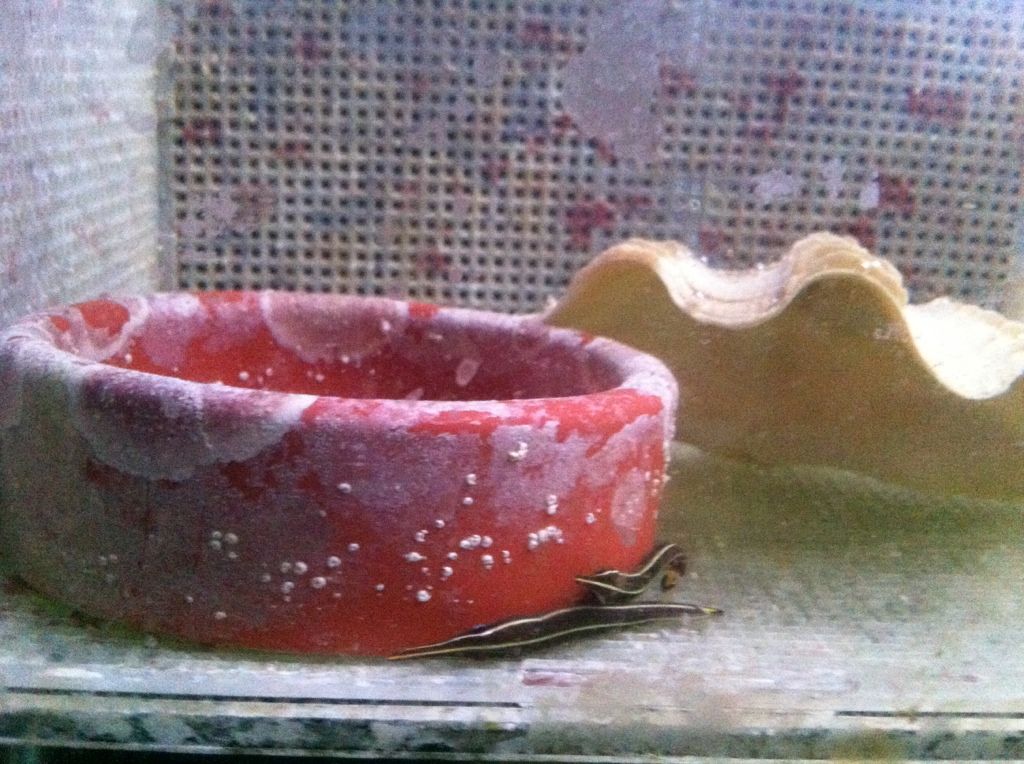 I put them in a breeder basket in the QT and started by feeding them live brine. They have VERY small mouths and seemed to get nervous about larger food particles. However, within several days I had them eating nutramar ova out of a feeding dish.  Over the next several months I was able to do a bit of research and acquire additional females and two males. All the fish were kept together and there was very limited aggresssion between them. The smaller male did die though. I am not sure if this was because he never aggressively ate any food, or if the larger male bullied it to the point of death. The four females have virtually no problem with one another. The only posturing or aggression I have seen is when they are waiting to be fed. Here are the two males (now down to just one): 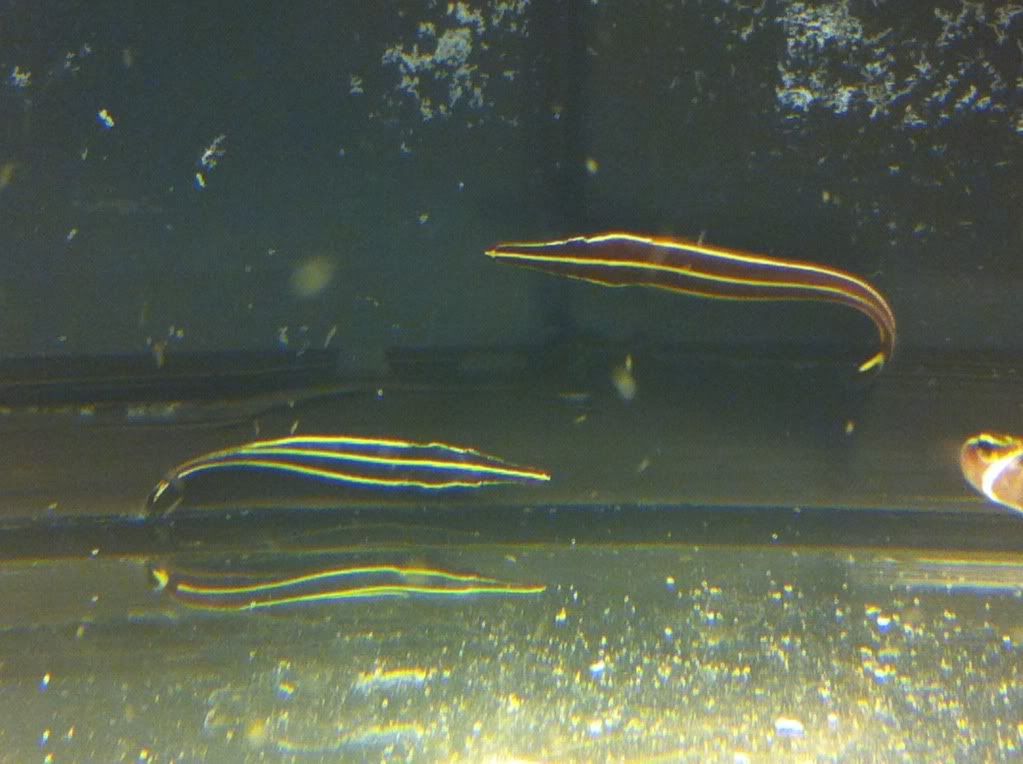 A male in a clam shell: 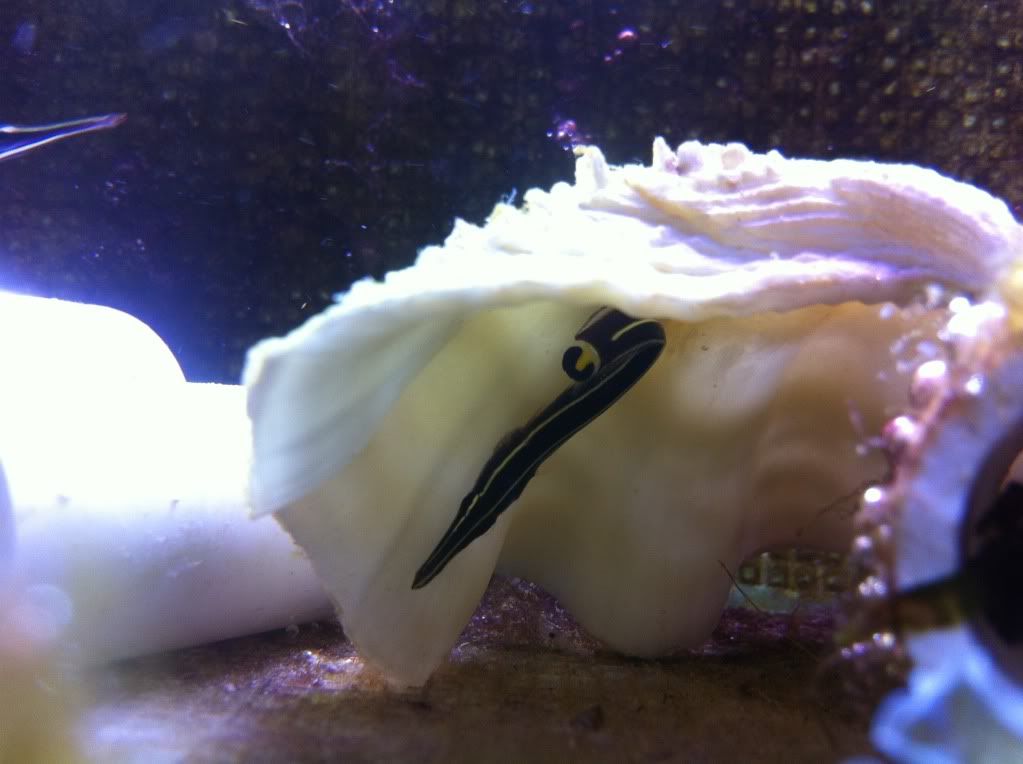 I put the clam shells in because in the wild this is their natural spawning "cave"--empty bivalve shells. Apparently the males fight voraciously for them since they are difficult to find. Here is a pic of a female: 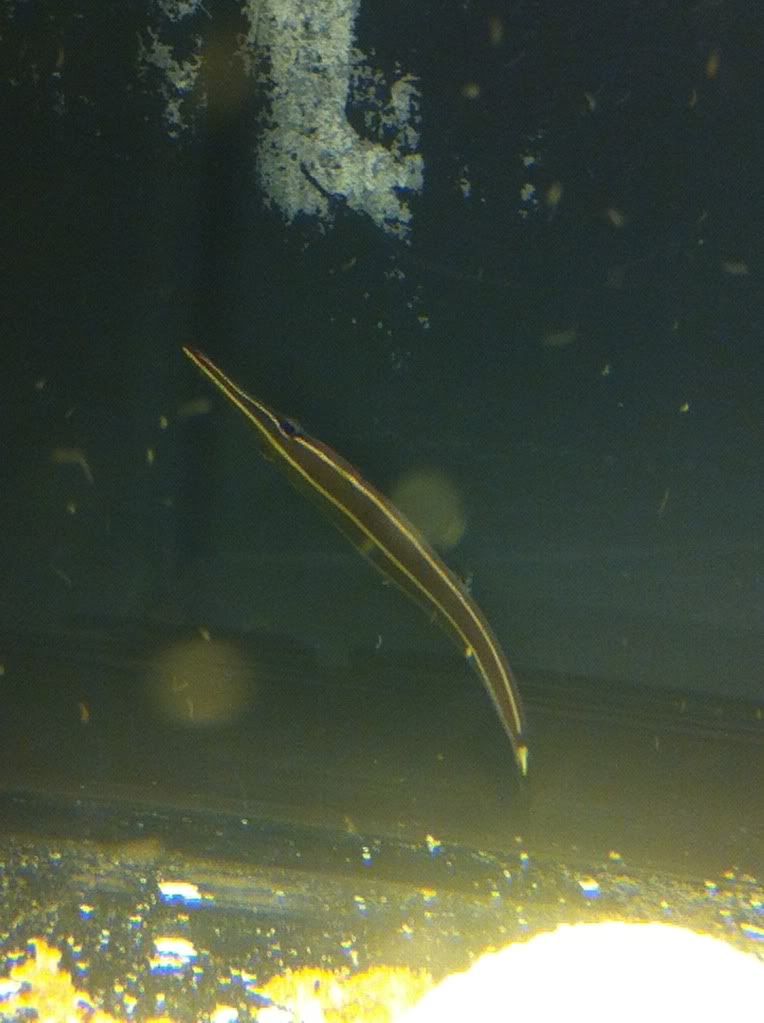 Males and females together so you can see the difference in snout shape: 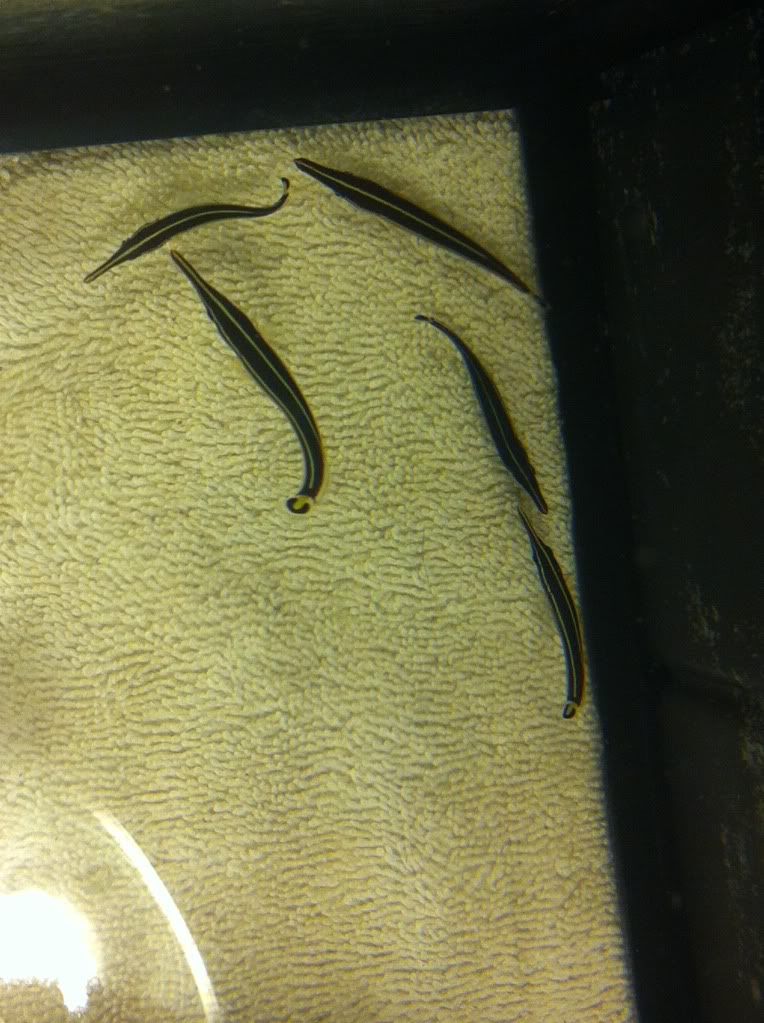 Of the fish I have, the males have been more difficult to wean on to dead foods. It also seems to take them some practice to snatch the food out of the water column. They don't snick, but sort of stab at the food. The five I have now prefer to eat slightly larger food over the individual ova. They take brine (selco enriched) eagerly and just this weekend began to eat Hikari mysis (two of the five). It's interesting because now that the male is eating dead foods, he is the most aggressive and willing to try larger foods.
|
|
|
 Re: Breeding Journal, Species: Diademichthys lineatus (Yellowstripe clingfish)
Monday, June 24, 2013 12:47 PM
Re: Breeding Journal, Species: Diademichthys lineatus (Yellowstripe clingfish)
Monday, June 24, 2013 12:47 PM
( permalink)
Eggs! 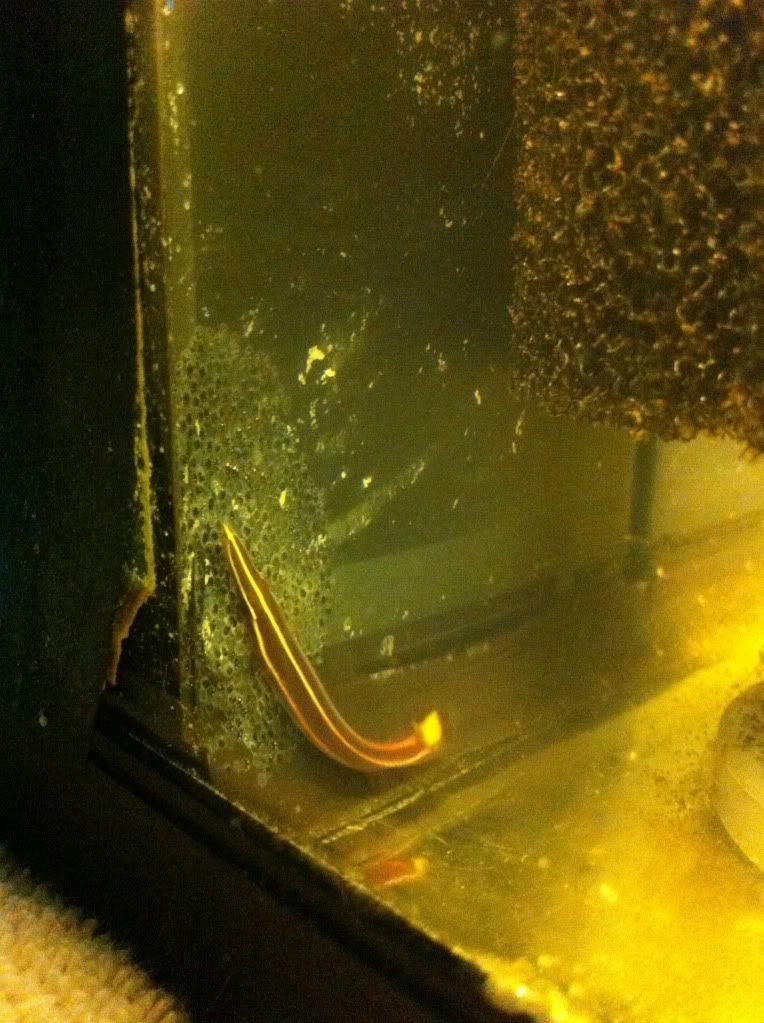 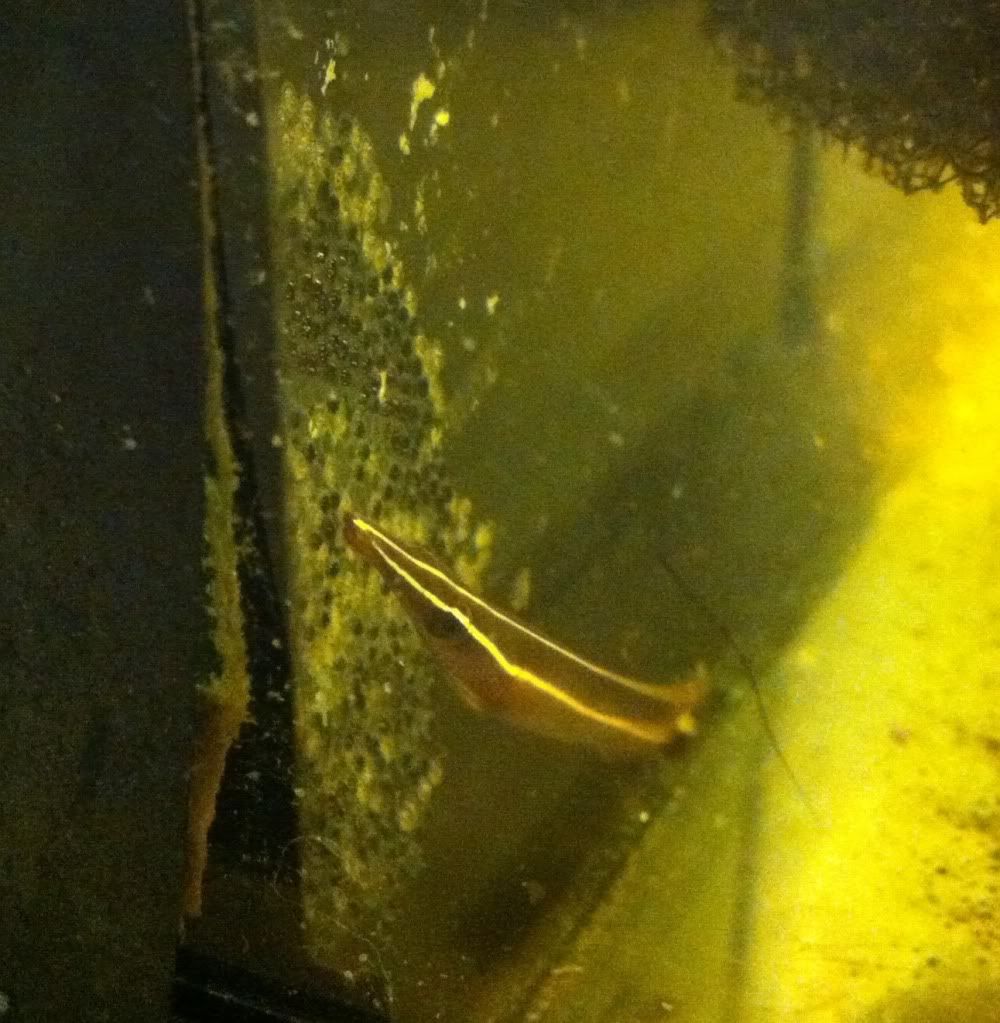 And some videos: 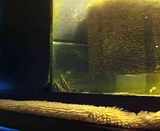 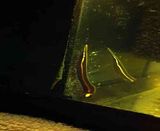 In the second video you can really see the color change in the male's stripes. Both videos were taken in the morning, but I haven't yet verified if that's when they actually spawn, or if that's just when courtship begins.
|
|
|
 Re: Breeding Journal, Species: Diademichthys lineatus (Yellowstripe clingfish)
Monday, June 24, 2013 2:37 PM
Re: Breeding Journal, Species: Diademichthys lineatus (Yellowstripe clingfish)
Monday, June 24, 2013 2:37 PM
( permalink)
The first larvae were found on 6-19-2013. I put the Vossen snagger in on the night of the 17th, but it fell. The night of the 18th I sort of rigged it with a clamp (the suction cups don't do well in the biocube because of the slightly curved corners) and I found larvae the morning of the 19th. It is possibly (even likely) that there had been previous hatches, I just never looked before the lights came on with a flashlight. The larvae are positively phototrophic and can be collected with a flashlight, however, I seem to only find them in the snagger after I turn the snagger light off for the night. Perhaps it is too bright and too close to the nest for them to hatch. The "Day 1" images are from the second hatch that I caught (morning of 6-21-2013), and the "Day 3" images are from the first hatch. The mornings of 6-22 and 6-23 I found one or two in the morning, but left them be. The morning of 6-24-2013 I found about 10 in the snagger so I collected them. All larvae so far have gone in to the same larval tank for the time being. In the future I will likely only collect "larger" clutches and separate them out into their own tanks. For now, they are all in a 3 gallon fish bowl. 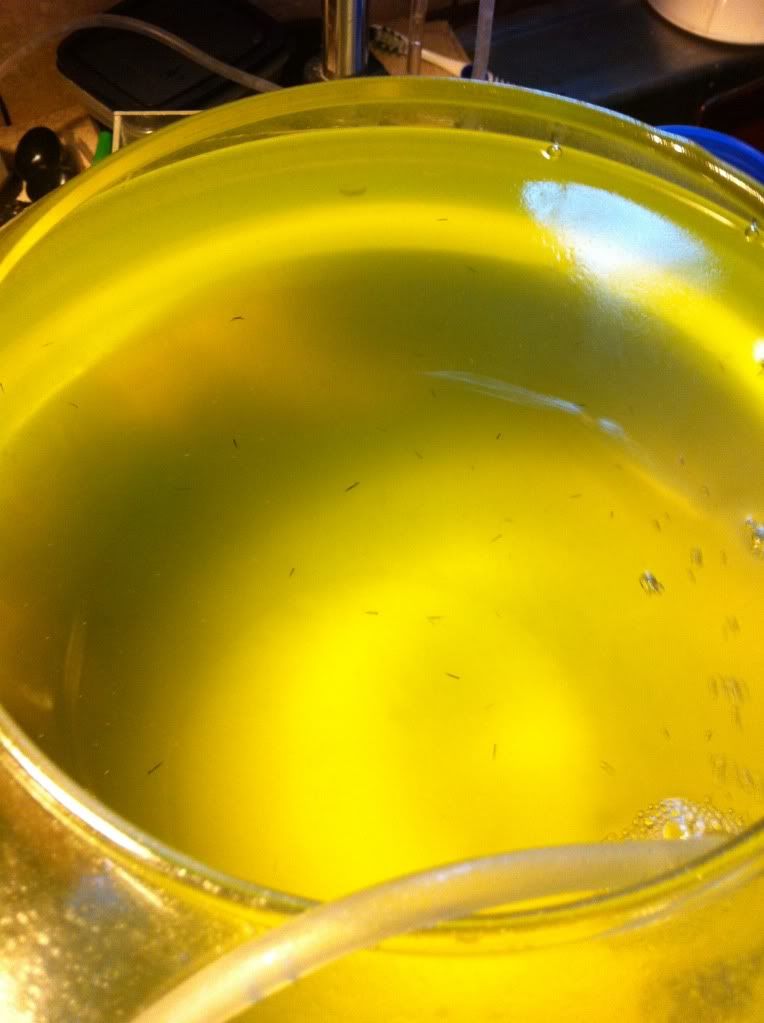 They have been fed rotifers and A. panamensis. So far I have put nannochloropsis, tetraselmis, and chaetoceros in for green water (today Isochrysis will probably be added). Day 1: 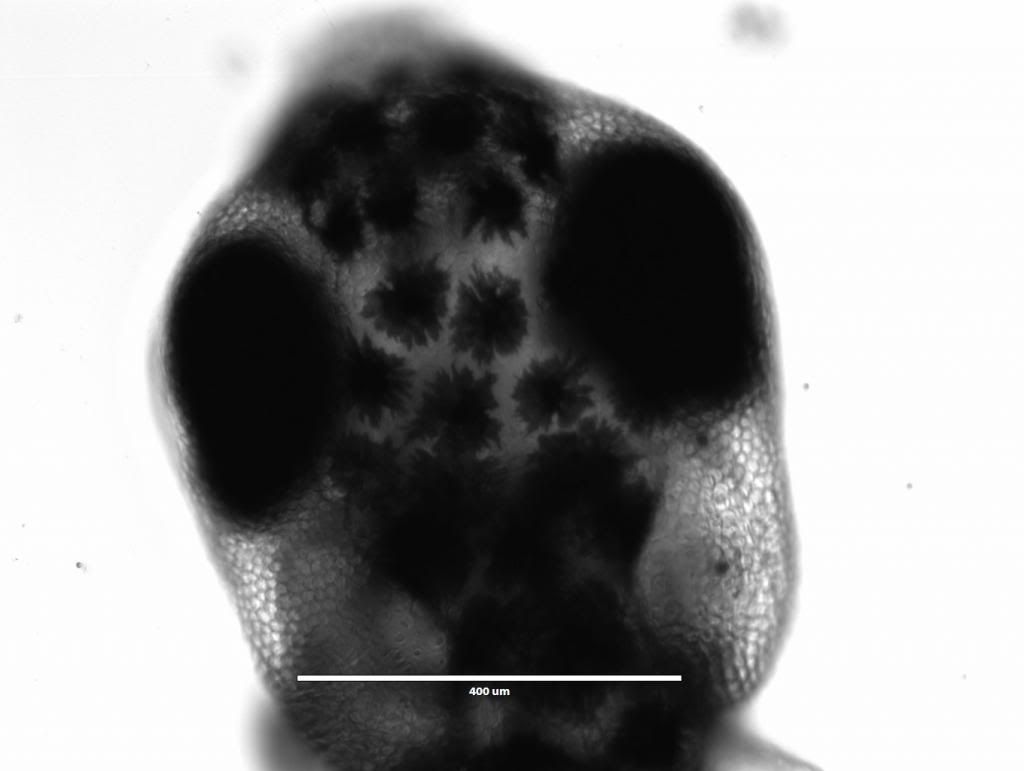 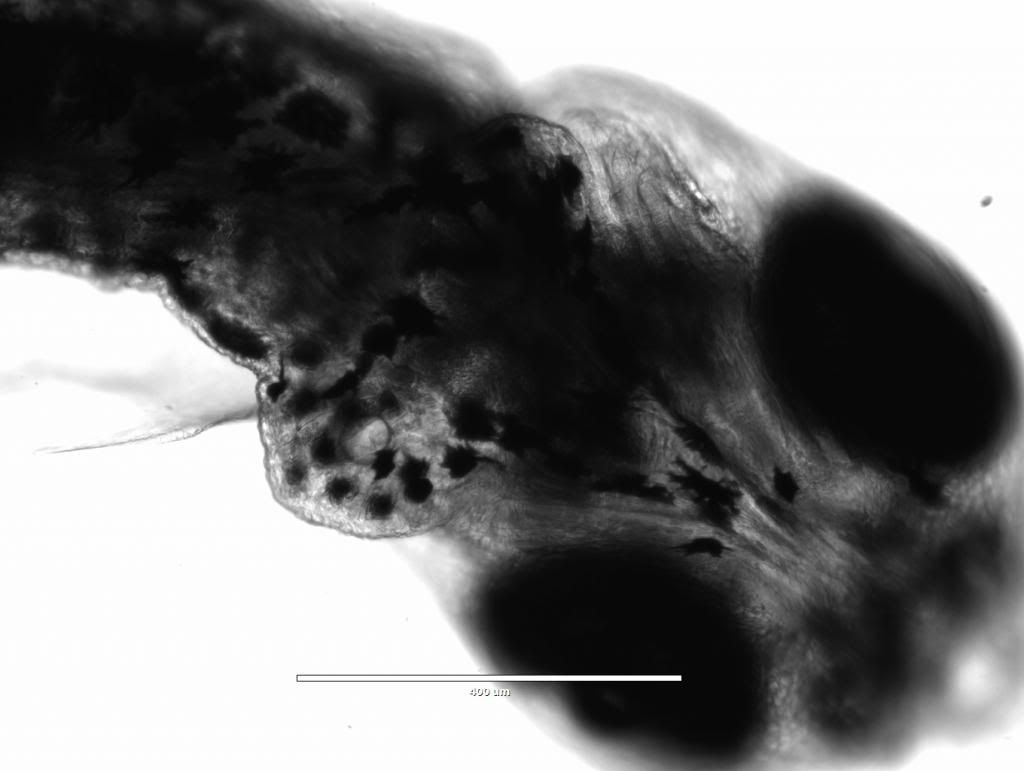 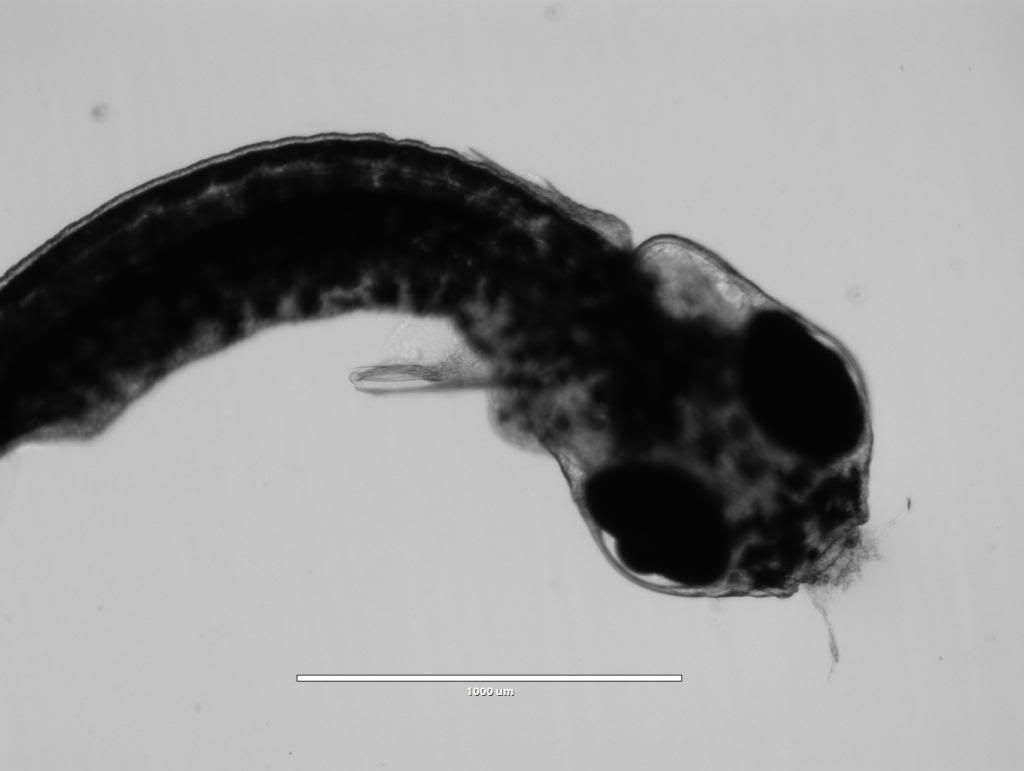 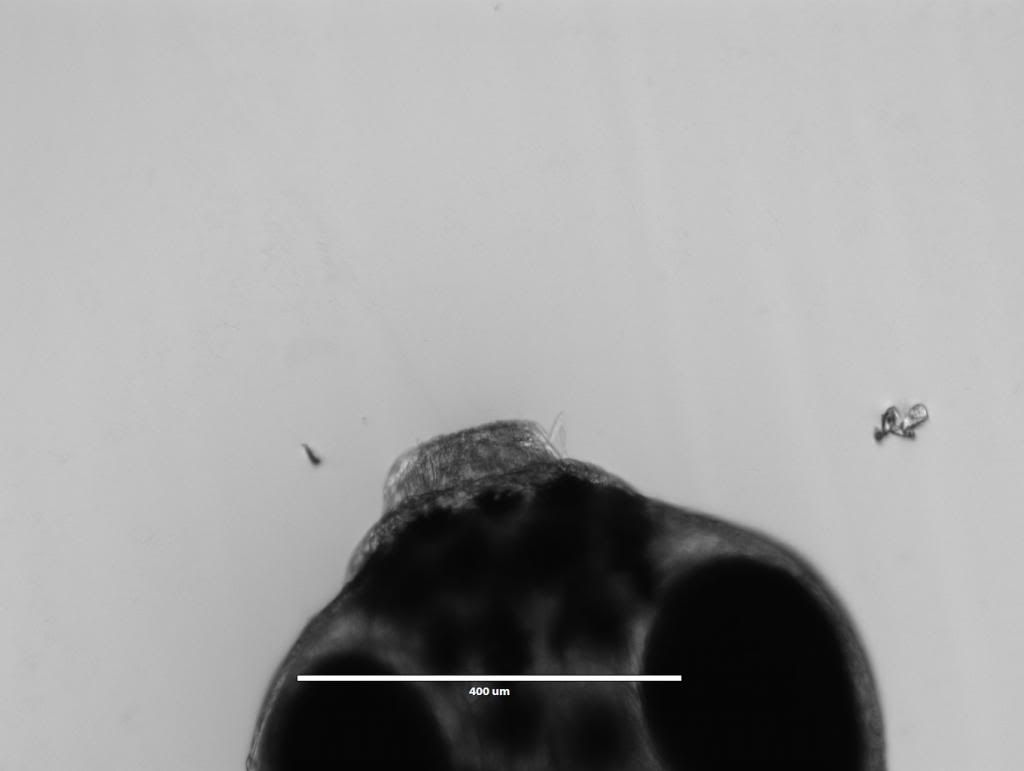 A composite image: 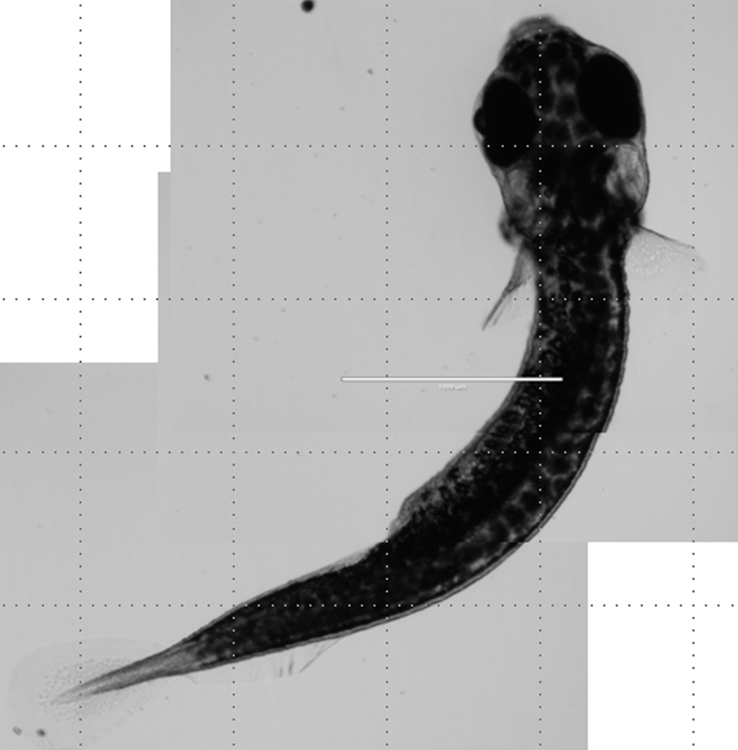 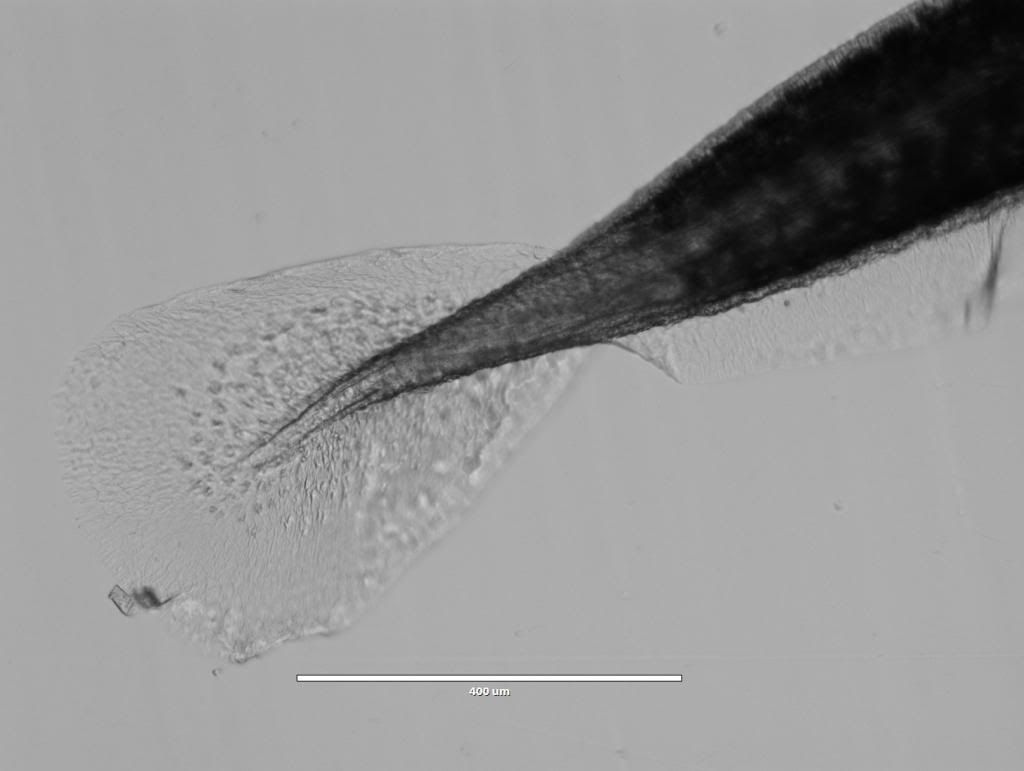 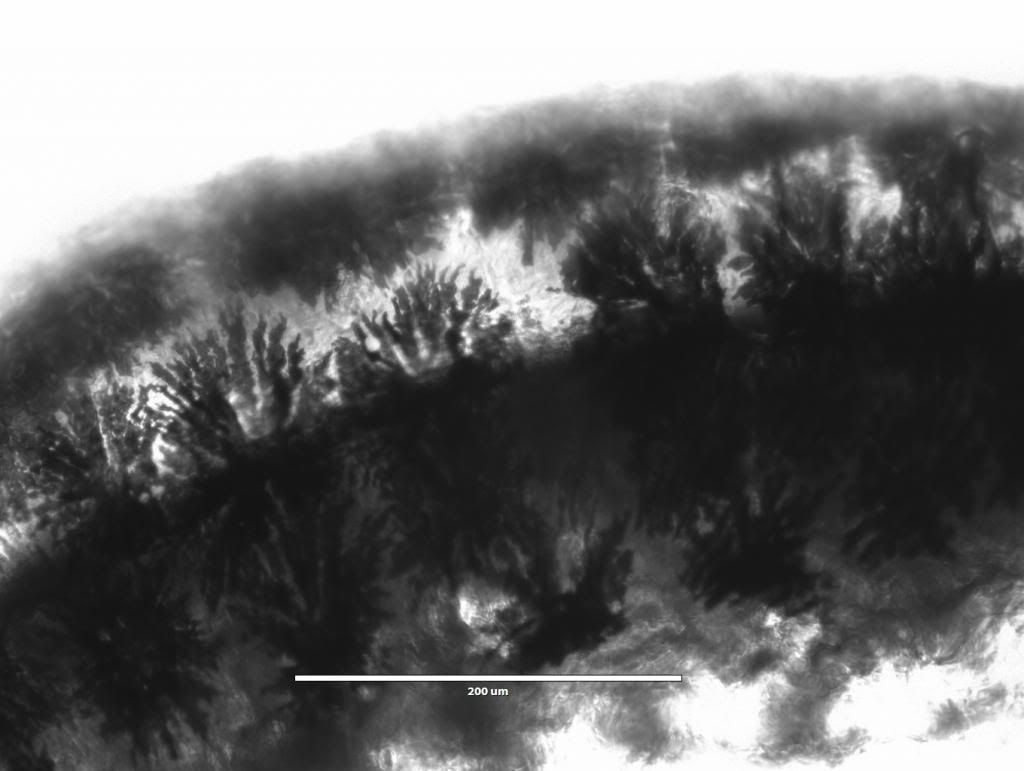 And Day 3: Tail: 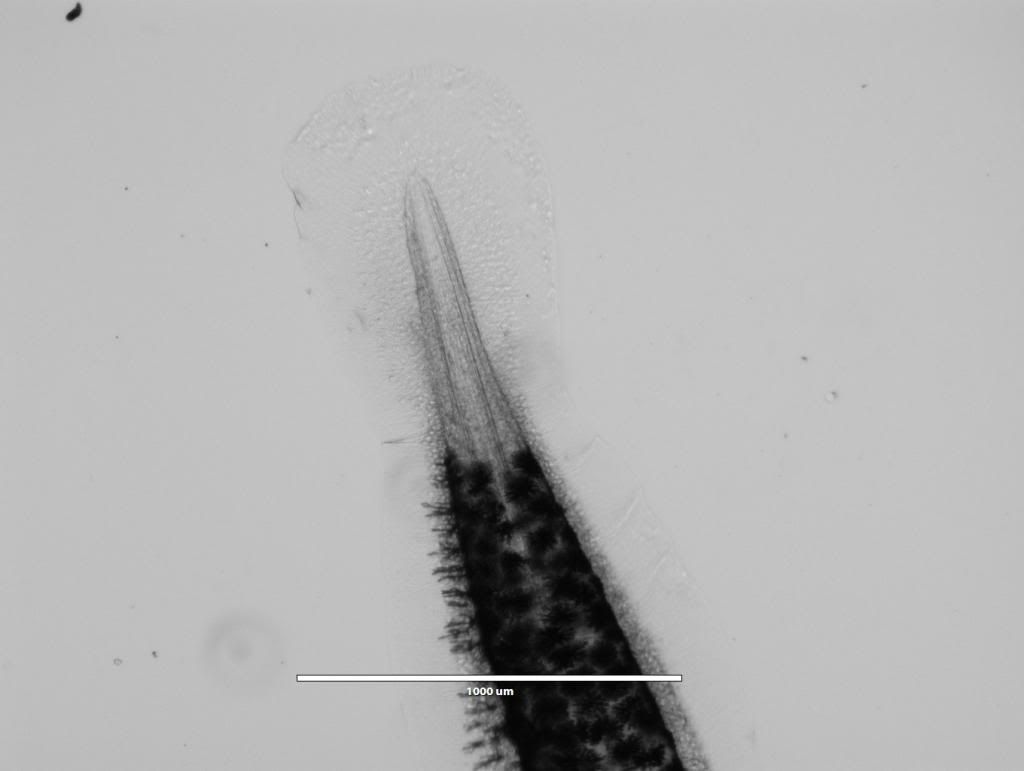 Pigments? 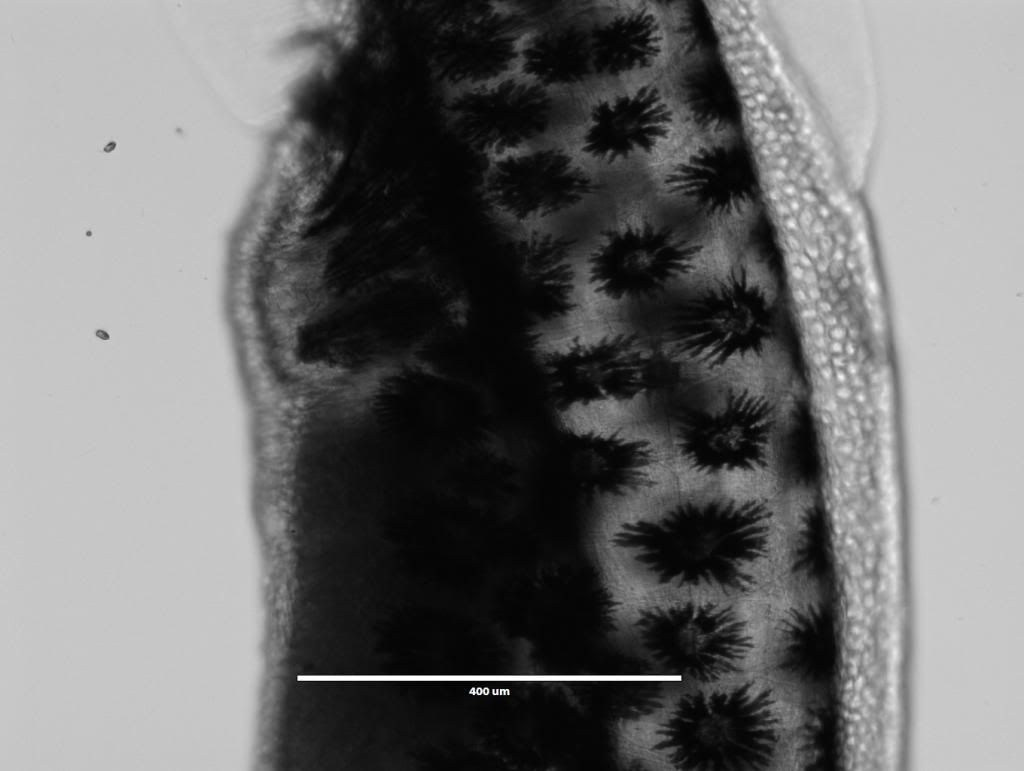 Overexposed to see the pigment spots (or whatever they are...) 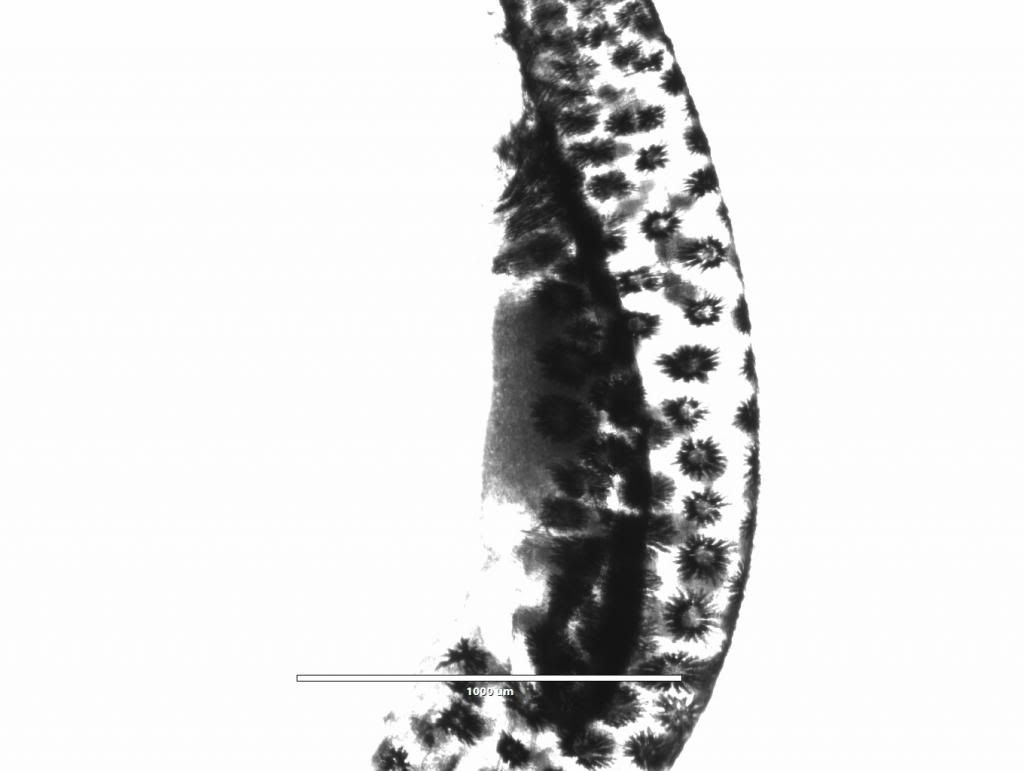 Head shot....eyes look weird because it was laying weird on the slide 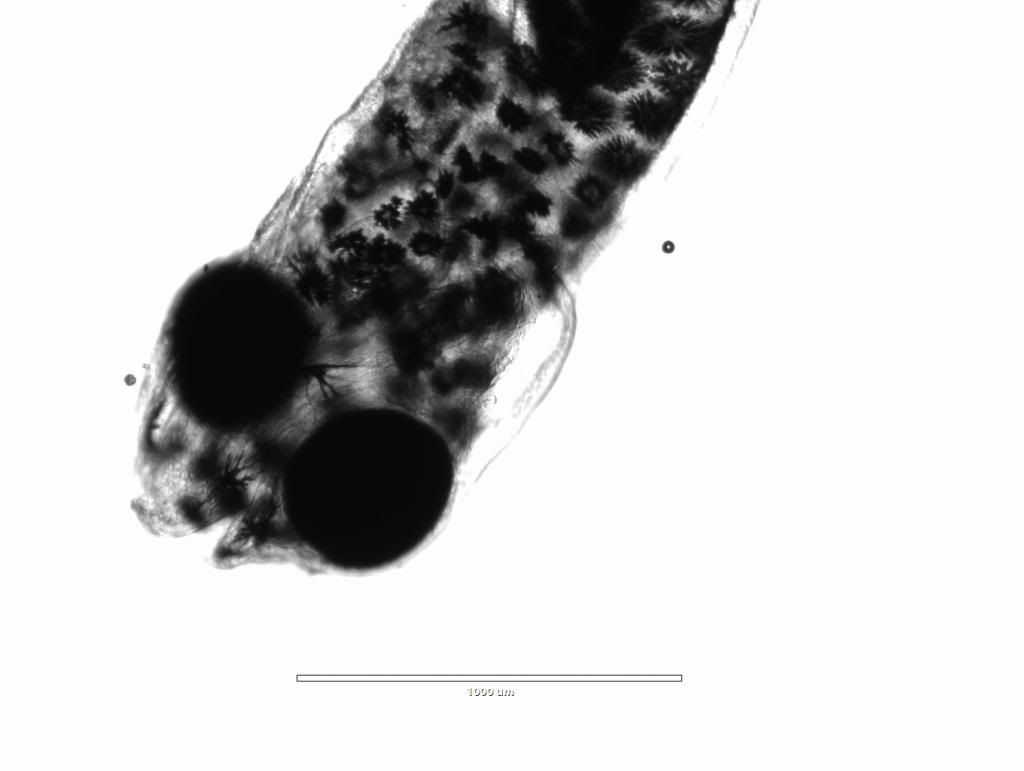 Close up of the mouth 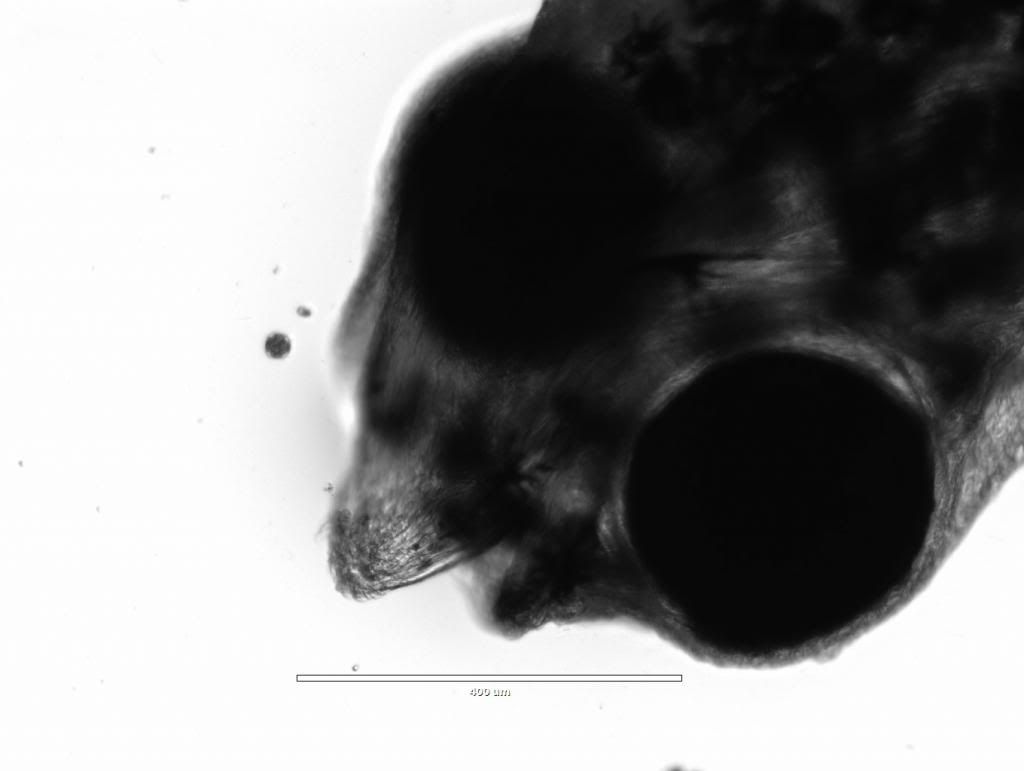
|
|
|
 Re: Breeding Journal, Species: Diademichthys lineatus (Yellowstripe clingfish)
Wednesday, July 3, 2013 9:50 AM
Re: Breeding Journal, Species: Diademichthys lineatus (Yellowstripe clingfish)
Wednesday, July 3, 2013 9:50 AM
( permalink)
This morning the male and one female was missing. I was concerned that they were sucked into the pump since it was making weird noises, but it turns out they were behind the tile spawning on the "wrong" side. This was approximately 7AM this morning, so as I had begun to suspect they spawn in the early morning, usually between 6AM (lights on) and 8AM. I snapped a quick pic of the eggs on the tile (sorry it's not very good but I was in a rush. I will try to get another tonight and then more as development progresses). I will also try to get a measurement of the eggs. I am happy they spawned on the tile because now I can hopefully determine incubation length and get an idea of how many eggs are laid per female.  Of the larvae I collected, I still have between 15 and 20. A couple days ago I noticed some of the dreaded larval killing pests (hydroids!) so I turkey bastered the larvae out, sterilized their bowl, and then replaced them back in with some new, aged ASW and Apocyclops panamensis (along with some Iso and tet). They also got some nhbbs this morning to see if they are interested in gobbling those up. I gave them just the smallest amount of rotifers just in case they can only eat those, but I am really trying to get them off of the rots and on to only copepods.
<message edited by shannpeach on Monday, July 8, 2013 9:06 AM>
|
|
|
 Re: Breeding Journal, Species: Diademichthys lineatus (Yellowstripe clingfish)
Tuesday, July 9, 2013 9:00 AM
Re: Breeding Journal, Species: Diademichthys lineatus (Yellowstripe clingfish)
Tuesday, July 9, 2013 9:00 AM
( permalink)
Last night, I had two larvae from the first round of spawning/collecting, but this morning they were both gone. I collected larvae on the morning of 7-7-2013 and again this morning (7-9-2013) and there should be more hatches nearly every night for awhile. The last couple have only been about 10 larvae each time. I've been taking photos every morning to get a better idea of how long it takes for the eggs to hatch, but I haven't been able to quite nail it down yet.
|
|
|
 Re: Breeding Journal, Species: Diademichthys lineatus (Yellowstripe clingfish)
Monday, July 22, 2013 12:16 PM
Re: Breeding Journal, Species: Diademichthys lineatus (Yellowstripe clingfish)
Monday, July 22, 2013 12:16 PM
( permalink)
All the larvae from the first attempts died ~10 DPH. I changed some things around and am gearing up for another hatch that I am expecting tonight (the eggs looked "ready" for two nights now...). I set up a BRT with the bottom painted white (17 gallon capacity) with ~3 gallons or so of water in it. I seeded it over the weekend with Tisbe and Nitokra and have been giving it small amounts of Iso and Chaetoceros. It looks like the eggs hatch anywhere from the 4th to the 6th night. Some eggs disappear on the 4th night, some are there until the 6th night. It's possible the male eats some and they disappear for that reason. Tracking the eggs is difficult even with the daily pics I took for awhile. I may have better luck labeling the tiles and pulling them daily, or putting a grid on the tiles so I can keep track of what egg is what better. Since they are now spawning on the tile, I have been pulling the tile out (and putting a replacement one in) every night after lights out and propping it in a water pitcher with an airstone under it. The bubble go over the eggs, but the flow isn't too strong. The eggs are pretty flat so they don't really move in the current. Then in the morning I check for larvae (haven't had any yet) and switch the tiles back. So the eggs stay with the male during the day, and with me at night. I am not sure if the eggs will hatch using this method or not, but if you only have 20 eggs at a time and you don't catch all the larvae...well, you don't have much to work with! Here are some egg sequence shots: 7-3-2013  7-4-2013 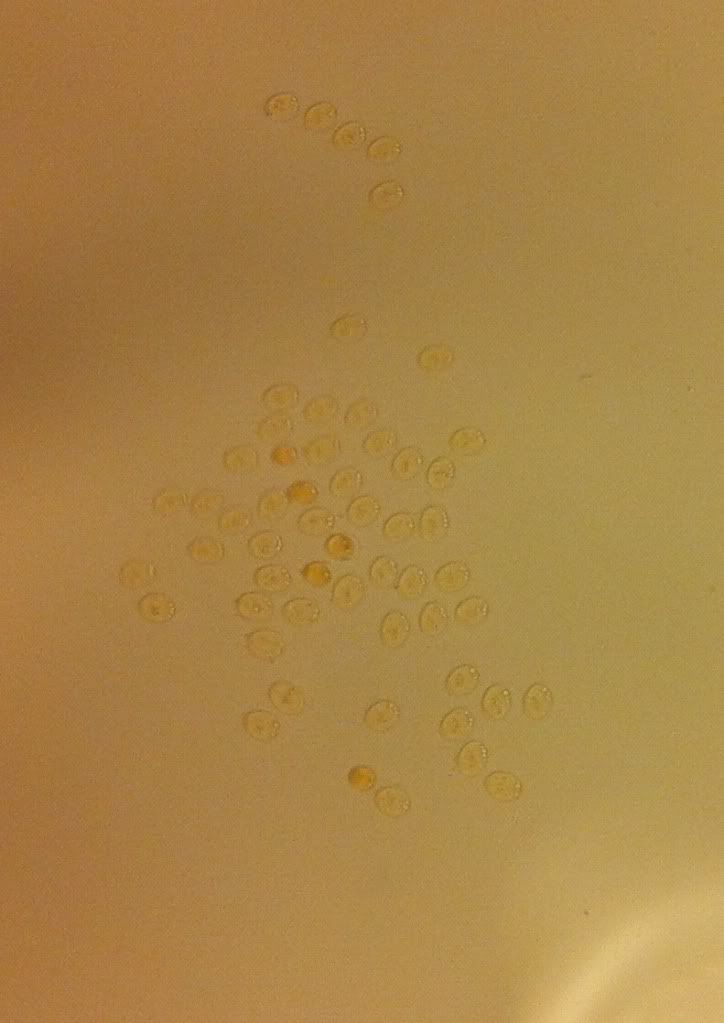 7-5-2013 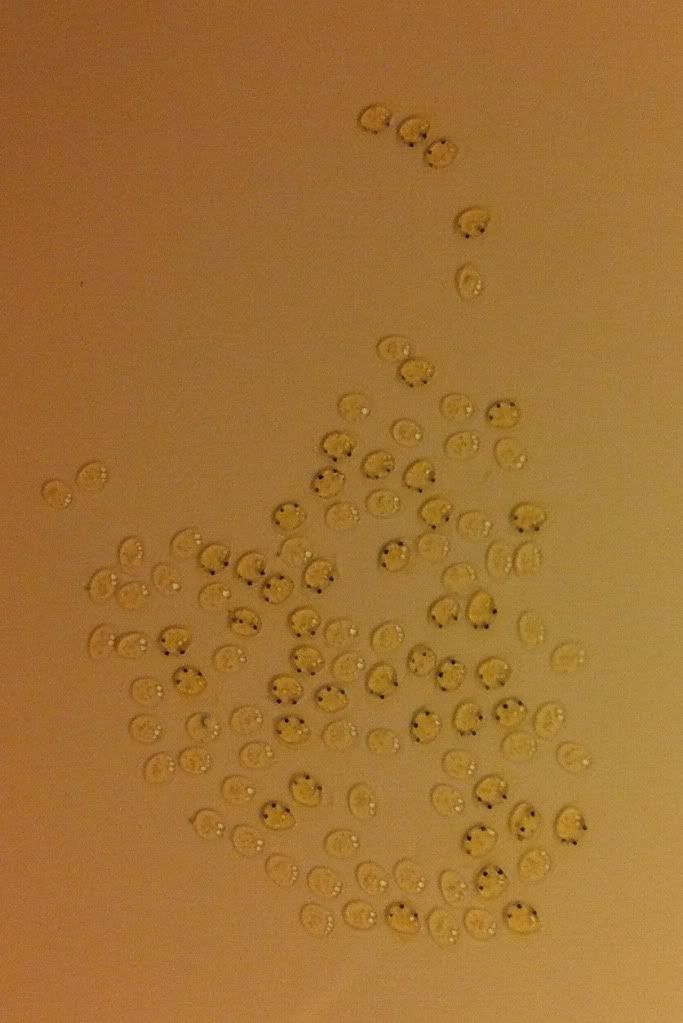 7-6-2013 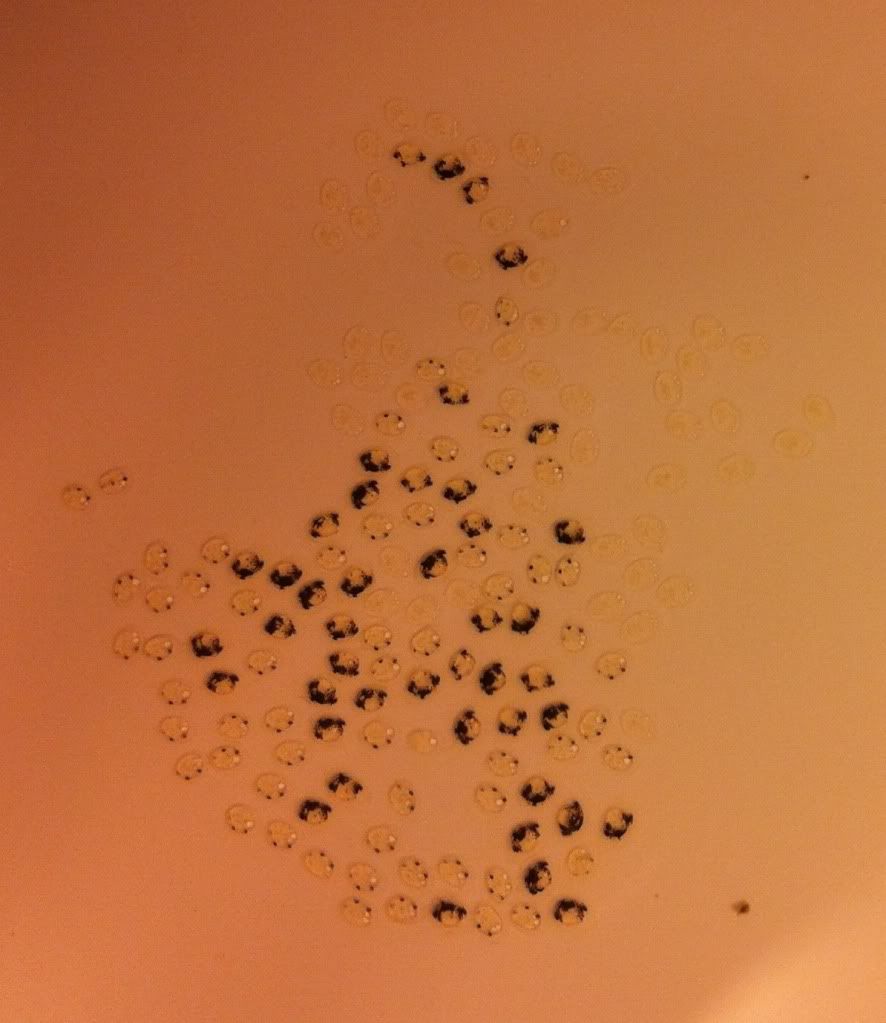 7-7-2013 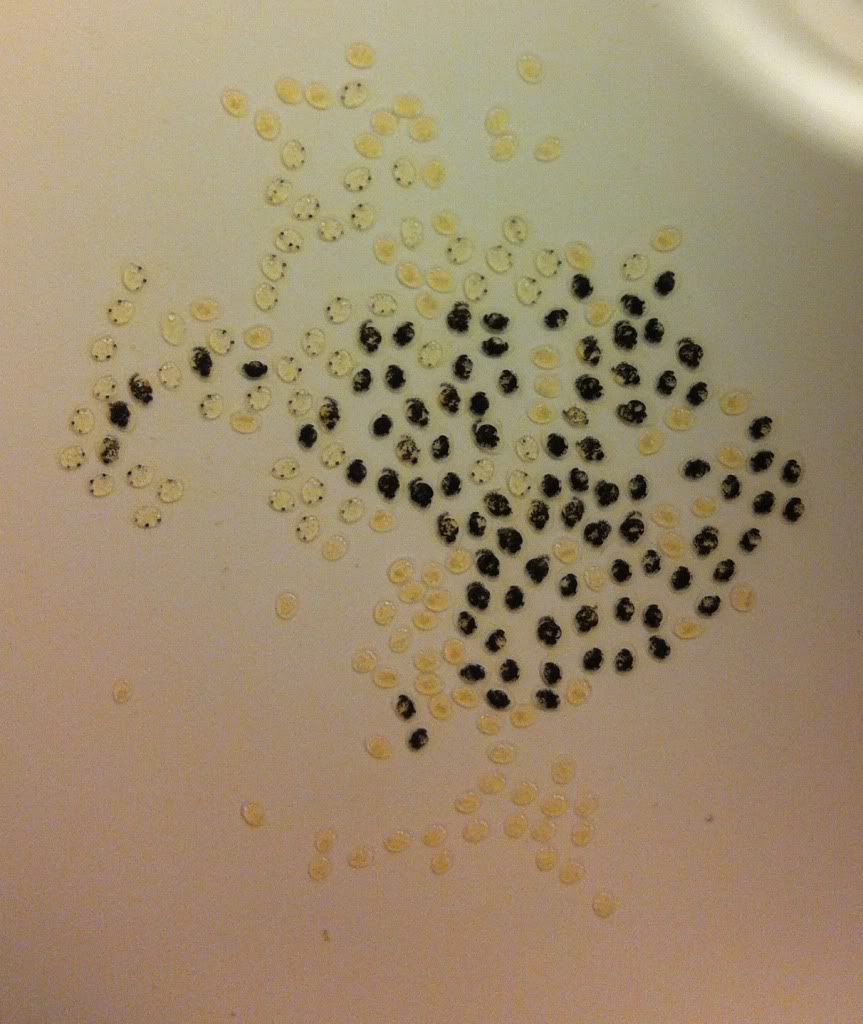 7-8-2013 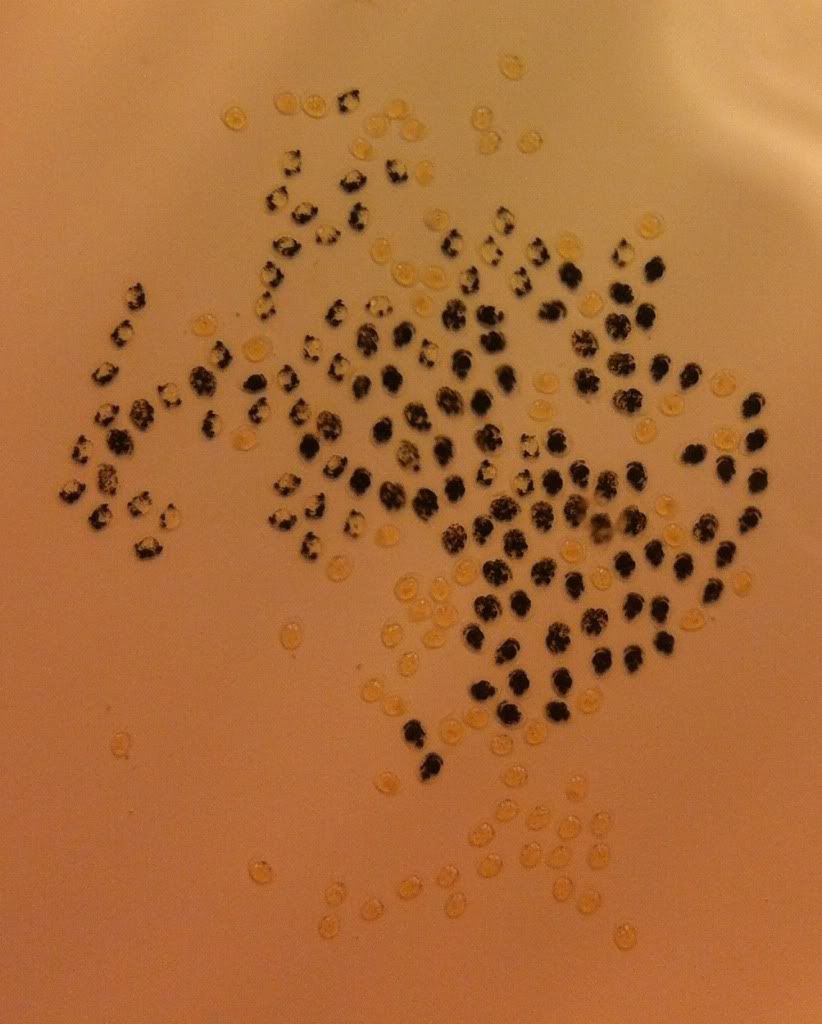 7-9-2013 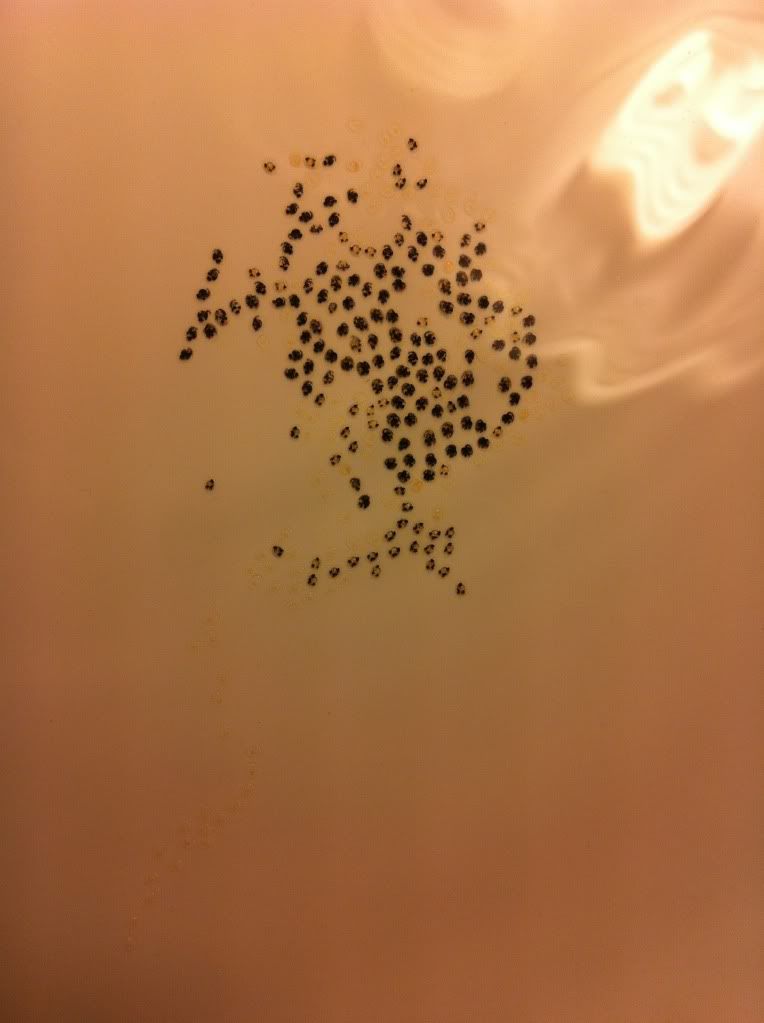 7-10-2013 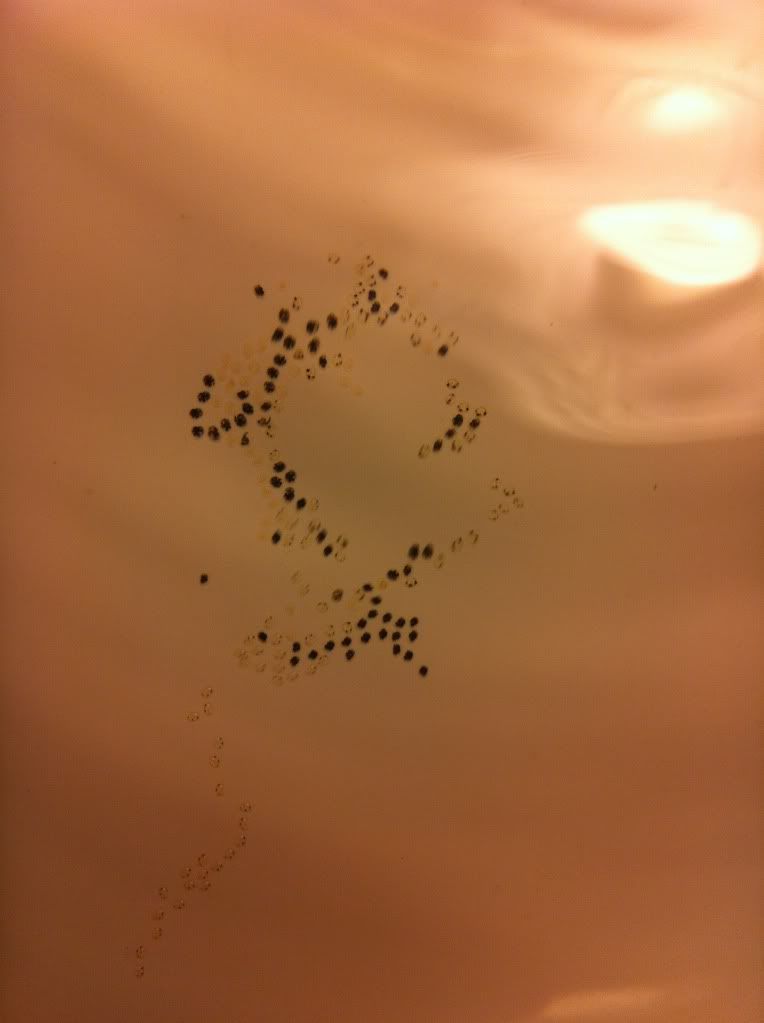 7-11-2013 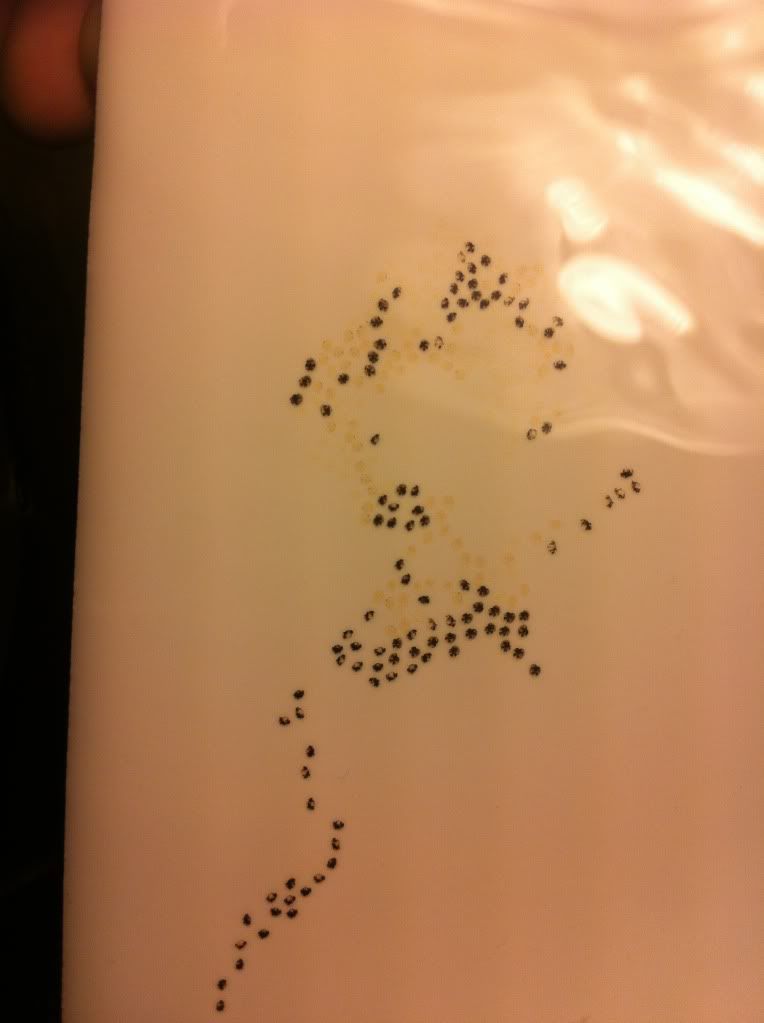 7-12-2013 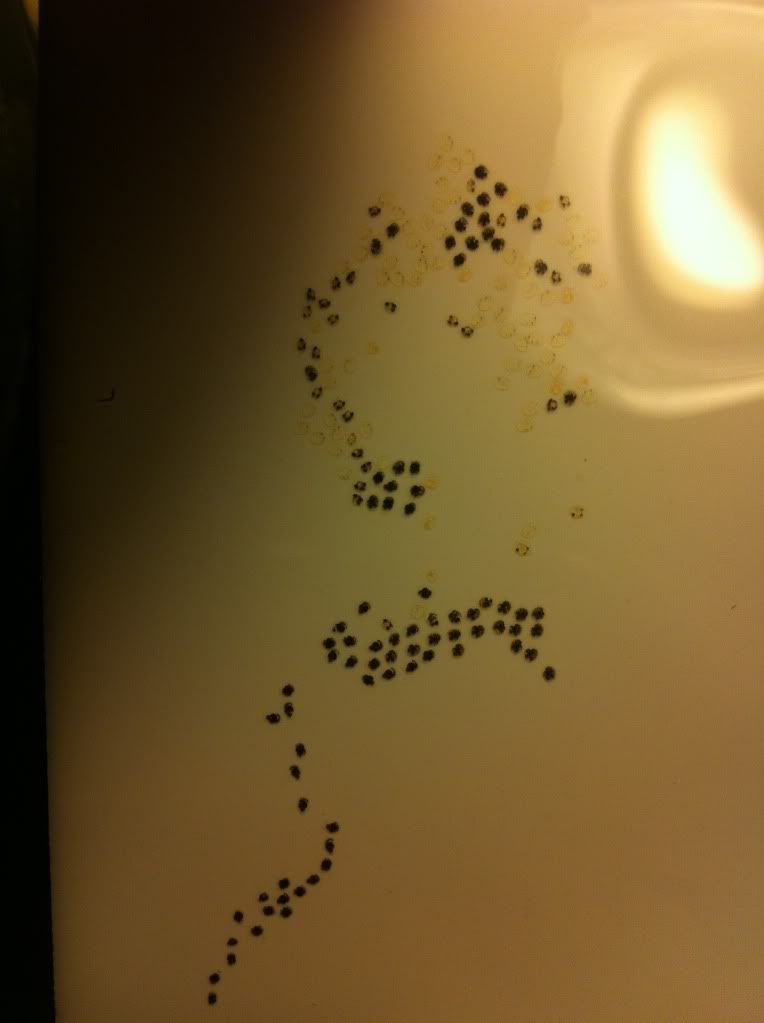 And that's the last of the daily sequence I had going. I will start another sequence soon. I may pull their current tile, put a new one in with a grid, and start tomorrow. Based on this though, it is at least the 4th night that they hatch, following the easy-to-track egg line that was laid on the 9th. There is a cluster laid on the 7th, toward the bottom, that seems to remain through a 6th night, counting the day they were laid as night 1.
|
|
|
 Re: Breeding Journal, Species: Diademichthys lineatus (Yellowstripe clingfish)
Monday, July 22, 2013 12:39 PM
Re: Breeding Journal, Species: Diademichthys lineatus (Yellowstripe clingfish)
Monday, July 22, 2013 12:39 PM
( permalink)
Keep up the fantastic work! (you're making me want to try these and race you!!)
|
|
|
 Re: Breeding Journal, Species: Diademichthys lineatus (Yellowstripe clingfish)
Monday, July 29, 2013 3:35 PM
Re: Breeding Journal, Species: Diademichthys lineatus (Yellowstripe clingfish)
Monday, July 29, 2013 3:35 PM
( permalink)
As of the 26th, they began to spawn on a new tile that has a numbered grid drawn on it. Hopefully this will help me keep better track. I didn't realize there were eggs until the 27th though, so that is when I began to take daily pictures. I decided to try to take pictures in the evening instead of the morning since they spawn in the morning and I want to get each day's eggs on the day they were laid instead of the next morning. I will take the pictures at least all this week (likely longer) and really try to nail down how many days to hatch. About a week ago I pulled the spawning tile with a few different clutches on it. I expected it to hatch within a couple days. Nearly 6 days went by and the eggs didn't die, but they didn't hatch either. They were kept in a water pitcher with an airstone under, at "room temp" which has been rather cool for us lately considering it's the end of July (Highs of like 65 for a couple days...). My guess is this had greatly delayed hatch. Then I saw one larva on the morning of the 27th, and I just put it in with my dottyback larvae. Then the morning of the 28th, there were 6 that hatched. I put them in the copepod BRT that has been waiting for some of these guys. Withing 12 hours, 4 were dead on the bottom. The other 2 I lost track of by the next morning and I am assuming they also died. This morning (7-29-2014), there were seven more larvae that hatched and I also put them in the BRT. I am assuming they will not make it very long. This is unfortunate... however, it does tell me that these eggs CAN be artificially incubated and hatched, so that's the bright side. When it is looking like the current eggs in the tank are nearly ready, I will pull the tile overnight and put it in a water pitcher that is clamped in the broodstock tank for temperature control and hopefully get a hatch (and catch ALL the larvae  ), and then give it back to the male in the morning. This has to be done FIRST thing in the morning, before the lights come on at 6AM because I have seen them spawn as early at 6:10AM. So they clearly waste no time getting busy. I now have one female that will pretty much eat anything. I don't mean anything that will fit in her mouth, I mean she will try to eat pretty much anything despite how big it is. I don't know how she fits some of it in that teeny tiny little mouth hole, but she does. And she has fought off a A. bicinctus clown that is nearly 3 inches and girthy to keep a piece of food that she is trying to cram in her mouth. I think this is great since it shows that they could hold their own against other tank mates when trained to eat prepared foods. She has started to even go after flake, but doesn't seem to have much of a taste for it. The others eat well, but not nearly as voraciously as the Hungry Female. I may try some small spectrum pellets soon.
|
|
|
 Re: Breeding Journal, Species: Diademichthys lineatus (Yellowstripe clingfish)
Thursday, August 1, 2013 9:36 AM
Re: Breeding Journal, Species: Diademichthys lineatus (Yellowstripe clingfish)
Thursday, August 1, 2013 9:36 AM
( permalink)
Bit of an update. The last of the seven larvae from the 29th died yesterday...not surprising. What IS surprising is the hatch I just got. Yesterday the eggs on the artificially incubated tile weren't looking as good. Some of the eggs looked like they were lifting off. Out of laziness, I left the tile for the day/night since I had to work until 10 and didn't want to deal with it. This morning, after NINE days of artificial incubation at room temperature (which has been swinging pretty wildly here) with eggs that were not laid right before the tile was pulled, I had 25 larvae swimming around in the water pitcher. I think that is pretty awesome. I don't expect these larvae to live as they can't be very strong, but I tossed them in the tub anyway. You never know.
The current spawning tile has eggs that look pretty close to hatching, so I will likely start pulling the tile each night starting tonight.
|
|
|
 Re: Breeding Journal, Species: Diademichthys lineatus (Yellowstripe clingfish)
Wednesday, August 14, 2013 9:13 PM
Re: Breeding Journal, Species: Diademichthys lineatus (Yellowstripe clingfish)
Wednesday, August 14, 2013 9:13 PM
( permalink)
The eggs on the grid-marked tile started hatching on August 6th and I think every night since then I have gotten between 1 and 30+ that hatch, usually between 10 and 15. The first several rounds went into a BRT with about 5 gallons of water, a heater, rots and a few Nitokra. The water is kept green or brown with live phyto. On the 11th I started to put the newly hatched larvae in a new BRT set up the same way. It is SUPER hard to see them in these tanks because they are so darkly pigmented. This mornings hatch (which was amongst the largest) went into a 1 gallon fishbowl with Nitokra, rots, iso for brown water and a rigid airline set to a slow bubble. I can actually see them in the fishbowl and hopefully I can get a better idea of when they are dying. I will also be able to do larger percentage water changes in that tank and perhaps occasionally offer them only copepods or mainly copepods.
|
|
|
 Re: Breeding Journal, Species: Diademichthys lineatus (Yellowstripe clingfish)
Thursday, August 15, 2013 3:20 PM
Re: Breeding Journal, Species: Diademichthys lineatus (Yellowstripe clingfish)
Thursday, August 15, 2013 3:20 PM
( permalink)
Okay, so I finally put together the series photos. Each date's picture is labeled on the bottom right. When I started the series there were already eggs, so I started counting once I saw some easy to track eggs. I put a blue box around the eggs that I decided to track and the number is for Night 1, 2, etc. The pictures were taken in the PM, so any spawns for that day should have already been laid. (Sorry for the odd color on the first couple pictures; it took me a couple days to figure out the best lighting situation) 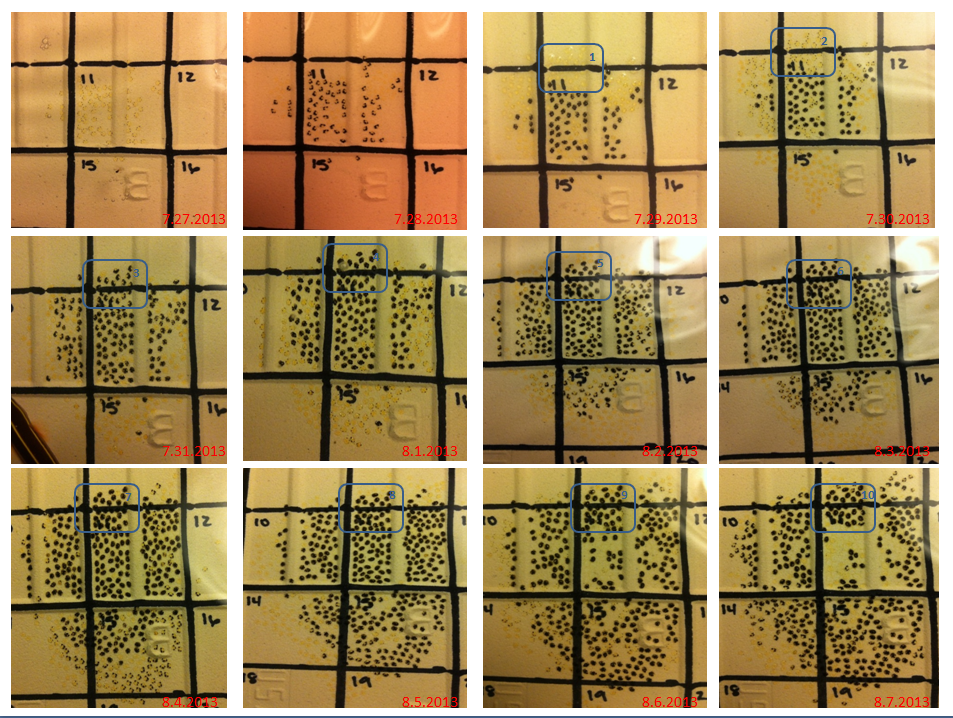  As you can see, on August 9th, most of the eggs are gone, meaning that they hatched the night of August 8th, Night 11. This is at 78*F. On August 2nd you can see some eggs laid just above the eggs being tracked, and they are gone the next day. I am not yet sure if the male is eating eggs (which they are known to do in the wild to maintain body condition during spawning season) or if they were not fertilized. I have seen more than one female in his little tile condo on more than one occasion and I am not sure if he is fertilizing all of the eggs that are laid by the females (how could he possibly keep track with all those ladies??) I plan to do more egg series in the future, but to answer the following questions: -How long is the incubation period at 80*? (I started "warming" the tank back up. In the summer I usually turn all the heaters down to lower baseline temps since my house keeps warm enough that I don't really need the heaters, but this summer has been a bit too cool) -How often does a single female spawn and how many eggs? To do this I will need to separate out one female with the male and I don't want to do that until I get some of these guys through (if ever  ) or until I see another male (I have seen a few more at the LFS and all have been female).
|
|
|
 Re: Breeding Journal, Species: Diademichthys lineatus (Yellowstripe clingfish)
Wednesday, August 28, 2013 8:36 PM
Re: Breeding Journal, Species: Diademichthys lineatus (Yellowstripe clingfish)
Wednesday, August 28, 2013 8:36 PM
( permalink)
A quick update. These guys seem to do well until they hit the 6-7 day mark and then they seem to stop feeding, start to drift, then sink to the bottom and die. They can be seen stalking and striking rotifers days after hatch, but for some reason stop. Not sure if the rotifers aren't being enriched properly or what. I have only really been using phyto (nanno, chaetoceros, tetraselmis, and isochrysis) for the rotifers in the tub and not enriching them beyond that. There are still some cruising around that are about 7 days old (will have to check my records for exact number of days), but my fear is that within the next day or so they will begin to drift and then die also.  I started collecting another round of larvae. It's been hot here for a week or so, so the broodstock tank has been at 80-82. I am not certain how long it took these eggs to hatch, but the ones I collected this morning seemed significantly smaller at hatch than previous ones, perhaps by up to 1mm (2mm at hatch versus the 3mm). They also didn't seem quite as darkly pigmented. I have them set up in a new BRT. Today I put in Apocyclops and a few Nitokra. I wanted to try this run also using Acartia, but the heat in the phyto station has had a negative effect on some of the pod cultures and I don't think I will have many (or any) to use.
|
|
|
 Re: Breeding Journal, Species: Diademichthys lineatus (Yellowstripe clingfish)
Monday, September 2, 2013 9:23 AM
Re: Breeding Journal, Species: Diademichthys lineatus (Yellowstripe clingfish)
Monday, September 2, 2013 9:23 AM
( permalink)
An update on my larval attempts. The last survivor I had made it to 8mm and 14 days and then seemed to stop eating, started drifting, and then died. I think there may be several problems. One, I may not be enriching the rotifers properly (currently using just live phyto, and no other enrichment methods). Two, rotifers may not be the best initial prey. Perhaps the deaths before the five day mark are related to improper prey size. Both those first problems I hope to remedy by switching to a mainly copepod diet the first week or so. Third, manually removing the larvae after they hatch may be damaging to them and then adding them to a separate tank may be shocking. I plan to switch to artificial hatching, but just haven't quite worked out a nice system to do that yet since the larval station has been at 24/7 lighting. Perhaps I should change that as well. This last run, where the oldest began to drift and die, it occurred to me that I didn't switch to a larger prey item early enough and perhaps rotifers were just no longer enough to sustain them. I can fix this by adding nhbbs or perhaps feeding a copepod diet instead would also help. I did pull one of the older ones this weekend (he was drifter, so I didn't have high hopes he would make it anyway) and took some pics: 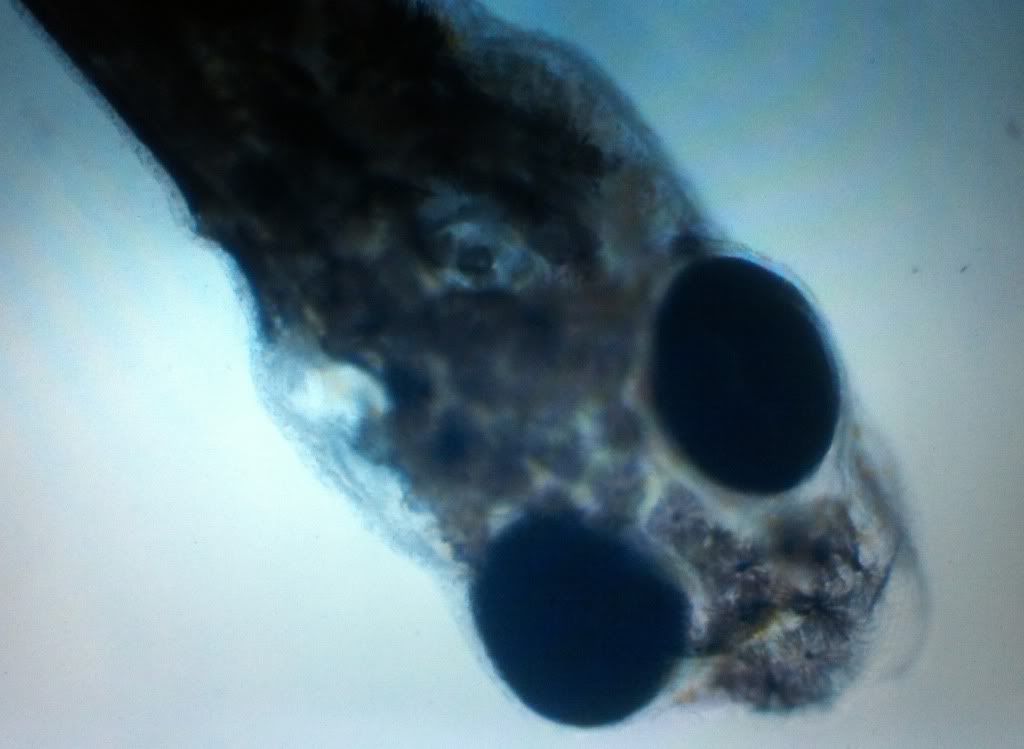 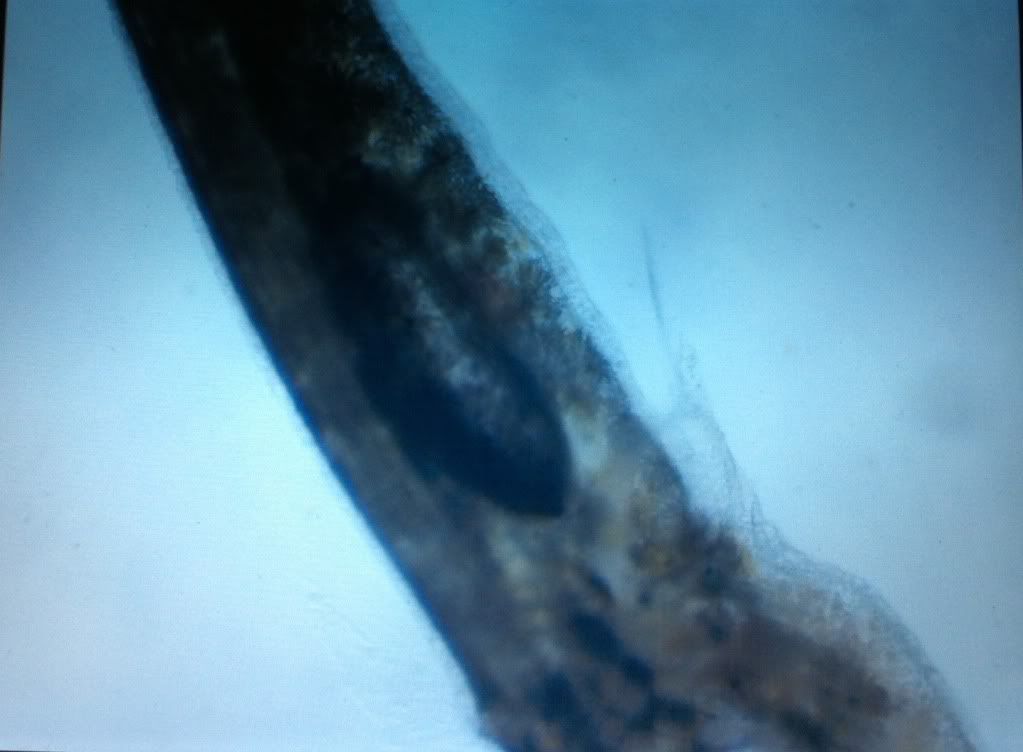 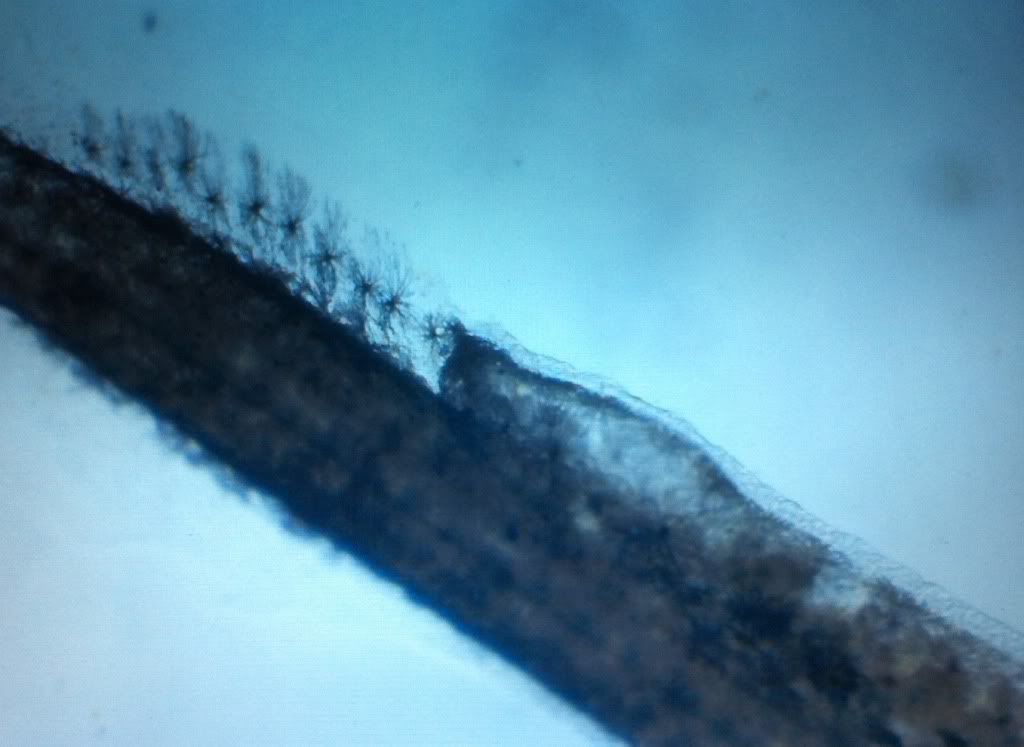 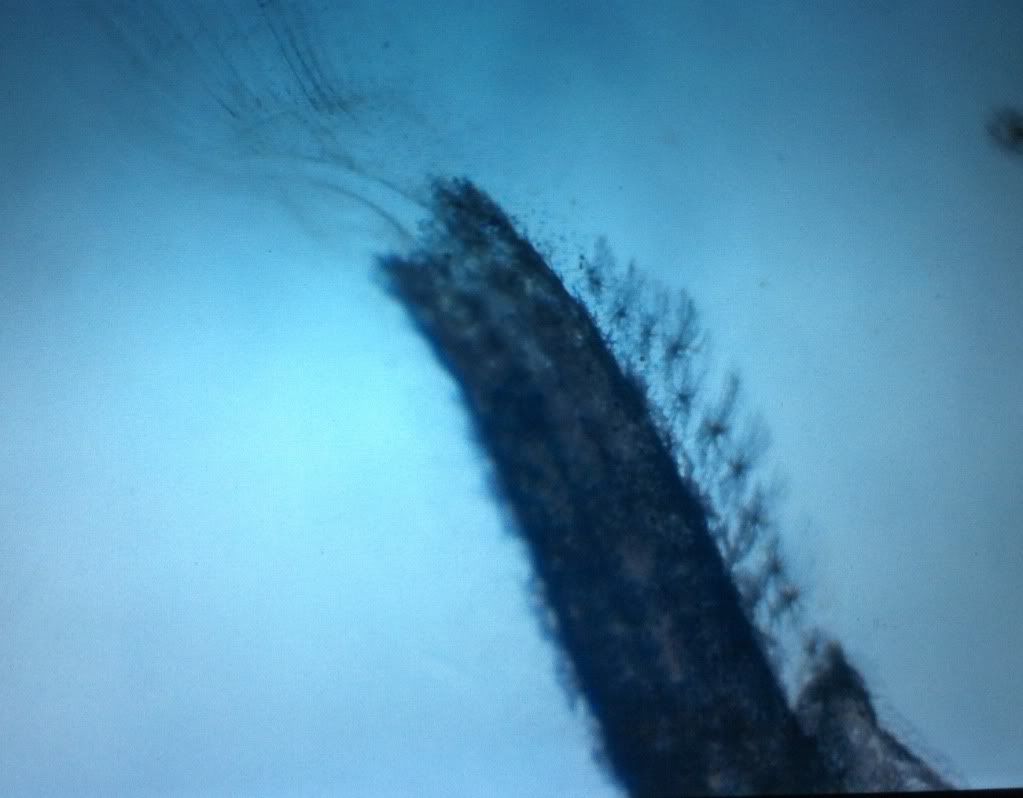 I also pulled a ~Day 5 larva that looked strong for some pics, but I haven't uploaded those yet. I will try to add them later.
|
|
|
 Re: Breeding Journal, Species: Diademichthys lineatus (Yellowstripe clingfish)
Monday, September 2, 2013 1:52 PM
Re: Breeding Journal, Species: Diademichthys lineatus (Yellowstripe clingfish)
Monday, September 2, 2013 1:52 PM
( permalink)
The day 5 larva: 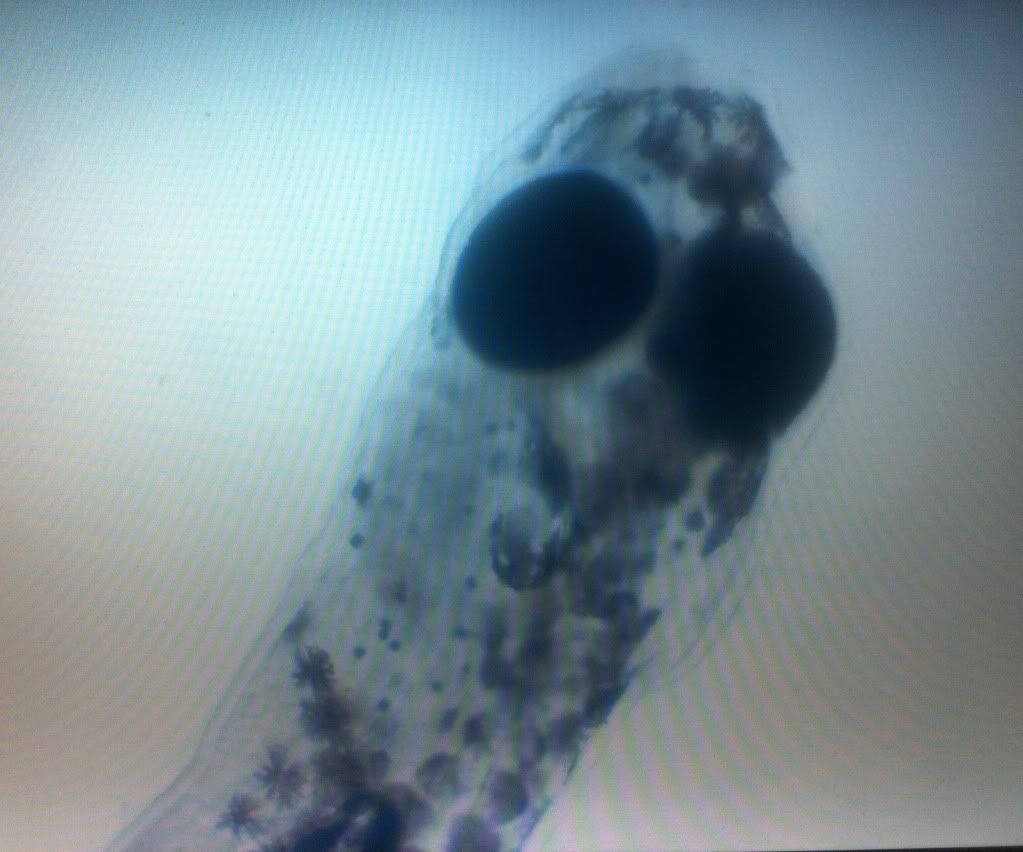 Midsection: 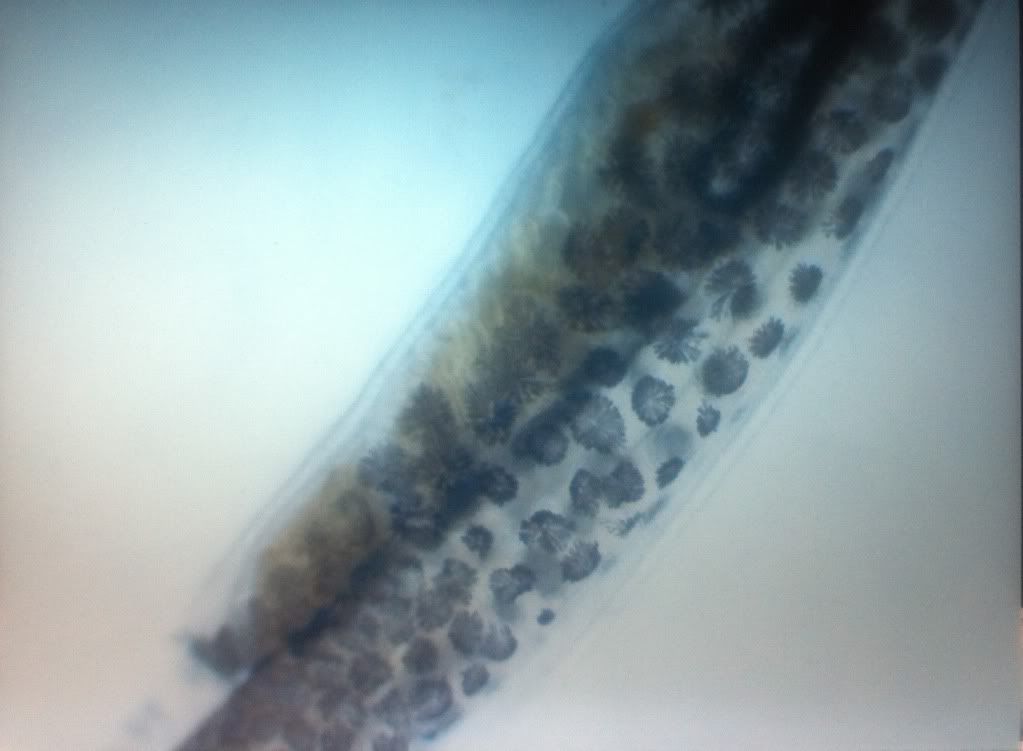 Close up of midsection/stomach, but couldn't focus well: 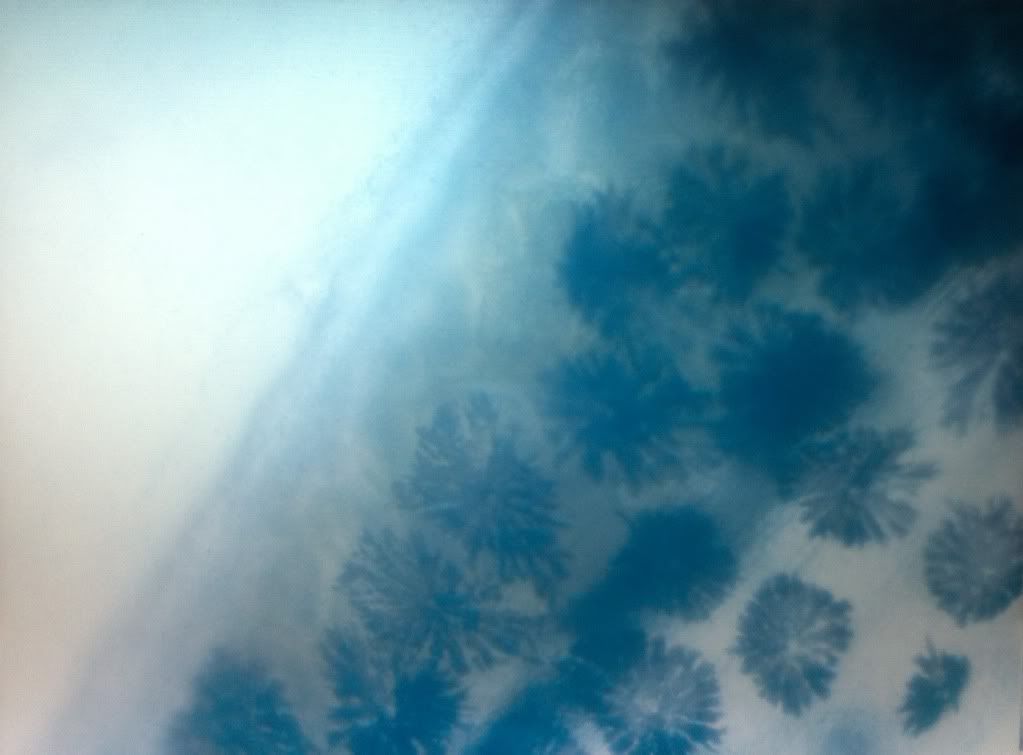 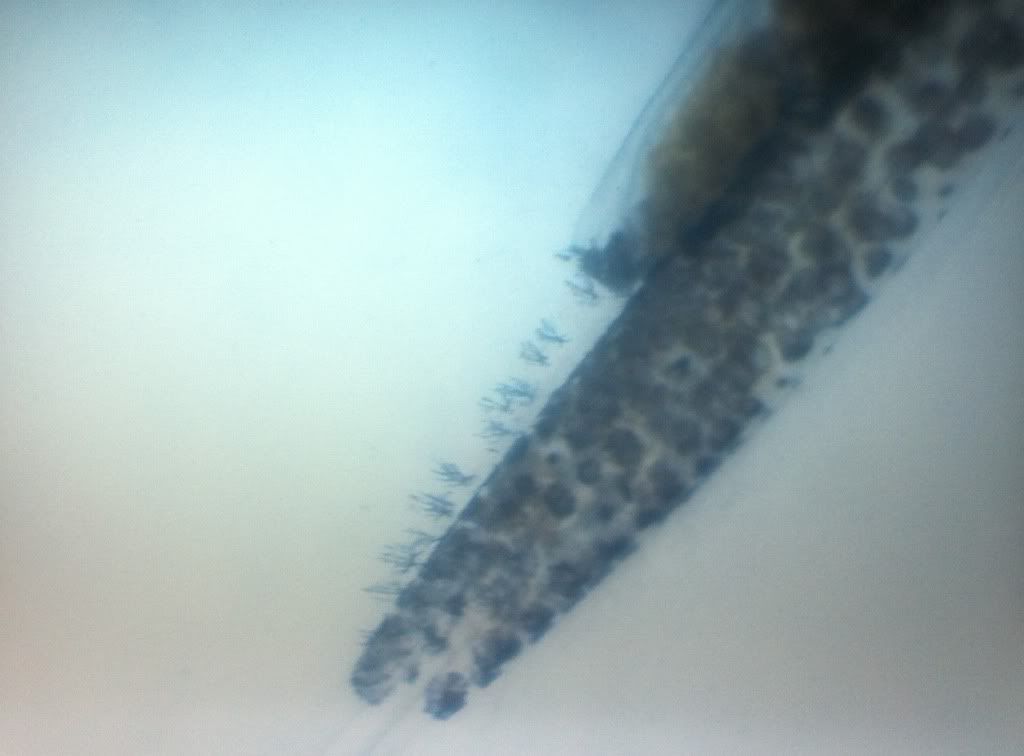
|
|
|
 Re: Breeding Journal, Species: Diademichthys lineatus (Yellowstripe clingfish)
Monday, September 9, 2013 3:31 PM
Re: Breeding Journal, Species: Diademichthys lineatus (Yellowstripe clingfish)
Monday, September 9, 2013 3:31 PM
( permalink)
One of the female clingfish died over the weekend. Cause of death is unknown. The other females and the male still look fine, so I don't believe it was disease related. I haven't had any large hatches lately and I am trying to stop collecting one or two here or there since it makes focusing on them difficult. I may try to find more females and enlarge the "harem" to try to get more eggs each day...
|
|
|
 Re: Breeding Journal, Species: Diademichthys lineatus (Yellowstripe clingfish)
Thursday, September 19, 2013 9:14 AM
Re: Breeding Journal, Species: Diademichthys lineatus (Yellowstripe clingfish)
Thursday, September 19, 2013 9:14 AM
( permalink)
I currently have a few younger clingfish larvae (less than 5 days old or so) and ONE that is now at day 16. I thought it was a goner for the last couple days because it looked pinched and drifty how the others have looked before they just sank to the bottom and died. The older one even spent some time laying on the bottom so I figured that he was done for. But I did two 50% water changes on the fish bowl yesterday and a 90% this morning and also added in some 10 hour enriched rotifers (and some pods were in there too). I also added in soms nhbbs again. Last time he wasn't interested, but I really think he/it needs a bigger food now. Or at least, a more nutritious one. Hopefully today he will try a couple of the brine. I do think I spotted a couple food items in its gut this morning, so hopefully he is eating again. Tonight I should know more....
There look to be more eggs ready to hatch than I've had lately (recently it's been between one and five eggs hatching a night). I haven't seen the male actually eat a lot during feeding but he is a fat little bugger so my guess is he is really chowing down on eggs. I would love to get another female (or two) in with him so I can get more eggs to hatch despite him eating so many!
|
|
|
 Re: Breeding Journal, Species: Diademichthys lineatus (Yellowstripe clingfish)
Friday, September 20, 2013 10:52 AM
Re: Breeding Journal, Species: Diademichthys lineatus (Yellowstripe clingfish)
Friday, September 20, 2013 10:52 AM
( permalink)
I did two 90% water changes yesterday, one in the morning and one at night. Was that necessary? I have no idea, but the drifter is still alive and he seems to perk up after a water change. Tonight I am going to take them all out and sterilize the bowl just in case there is some sort of bacterial issue coming into play around the two week mark. I had a "large" hatch of about 15 this morning (woo hoo!) that I added to the bowl so now I have quite the age range in there. Not ideal, but it is what it is. Couple things I've noticed the last couple days. First, chaetoceros is not the best to use for "greenwater" after it has been in the fridge for a day or so. It gets sort of...dusty and sticks to the bottom and side and everything gets sort of gunked up. So, last night I used some tetraselmis instead and will now avoid the chaetoceros unless it is fresh out of the culture bottle! Last night I also decided to try feeding nhbbs (I mean, come on already, you're 16 days old!) and even though a couple days before that he had NO interest in them, last night I swear his little gut was a bit orange! And what's even cooler is that one larva that is like 10 days younger than the oldest one also had an orange gut. Now I have tried adding nhbbs before in this run and previous and zippo interest. However, I recently switched to san fran brine (smaller hatch size, IIRC) and perhaps that was the trick. We'll see. Old Larva was still looking drifty this morning and there was no more orange in his tumtum, but I added the few nhbbs I had left in the fridge and I am hoping for the best. I also added some rotifers (L strain) since there are a bunch of new larvae in there now too. Some pics of the Day 16 (I thought I was "sacrificing" him but I put him back in the bowl and he apparently found a new will to live. At least for the night.): 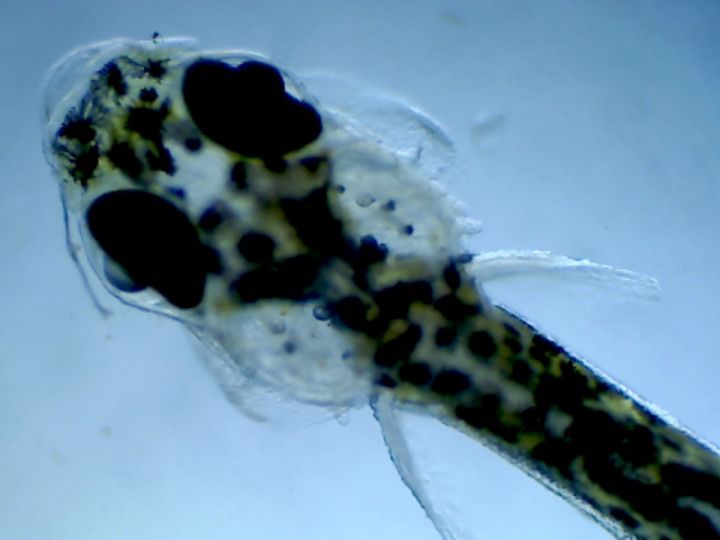 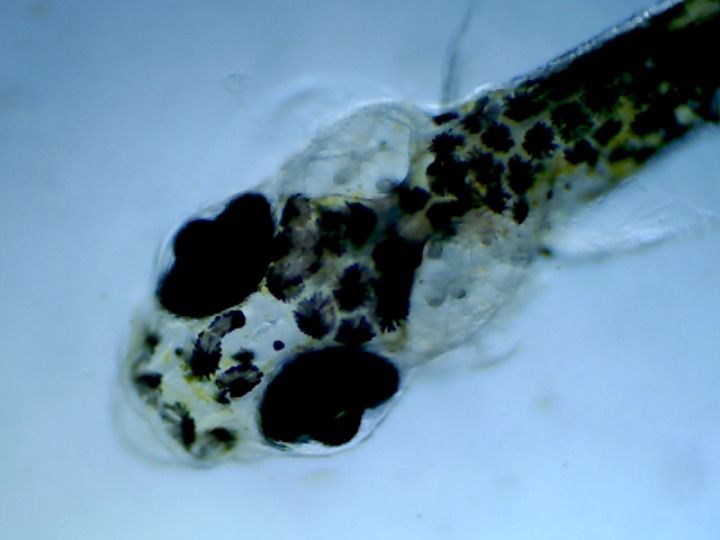 And the midbody: 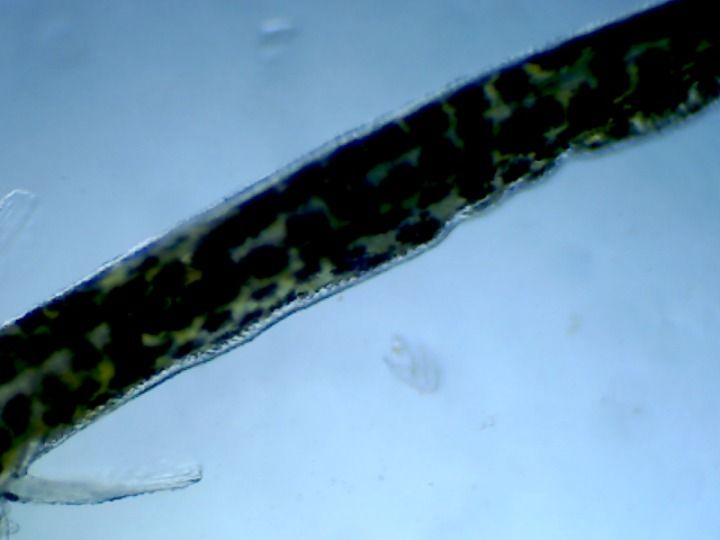 Didn't see any food in there...but then later I think he ate some nhbbs (it was orange, I swear!)
|
|
|
 Re: Breeding Journal, Species: Diademichthys lineatus (Yellowstripe clingfish)
Saturday, September 21, 2013 11:17 PM
Re: Breeding Journal, Species: Diademichthys lineatus (Yellowstripe clingfish)
Saturday, September 21, 2013 11:17 PM
( permalink)
So...I wonder; when you're experiencing these losses, have you tried introducing Artemia nauplii the day before that stage yet?
|
|
|
 Re: Breeding Journal, Species: Diademichthys lineatus (Yellowstripe clingfish)
Monday, September 23, 2013 10:19 AM
Re: Breeding Journal, Species: Diademichthys lineatus (Yellowstripe clingfish)
Monday, September 23, 2013 10:19 AM
( permalink)
I have. I have tried in previous attempts and also a few days prior in the most recent attempt and there was absolutely no interest. Which is odd, because this last time I added it, even ones that were way, way younger than the oldest one were eating a few. The only things I can think of that were different this time is that I am using a different strain of artemia, or perhaps this last time I just nailed the right concentration of artemia in the container to get them interested in eating them (by pure dumb luck). I will say that even after being on brine for several days now, the older one still only eats the very youngest, smallest artemia naups in there. I have to remove them at least once a day, often twice a day or more so the container isn't overrun with ones it won't eat. It is also odd that even at a younger age (some only several days old) they will occasionally stop eating, start drifting and then die. Maybe there aren't enough rotifers or something...not sure yet. My main focus has been more so on the few older ones. Unfortunately, one of the younger ones eating brine I shocked to death with a too large water change (oops!) that dripped too fast, but the oldest one, now at day 20 is still cruising around. I finally managed to get a pic of him! This was taken yesterday, when it was 19 days post hatch. It's taken with my iPhone (which is pretty busted up!) so it isn't the best, but it's better than nothing. I plan to scrounge up my actual camera one of these days. 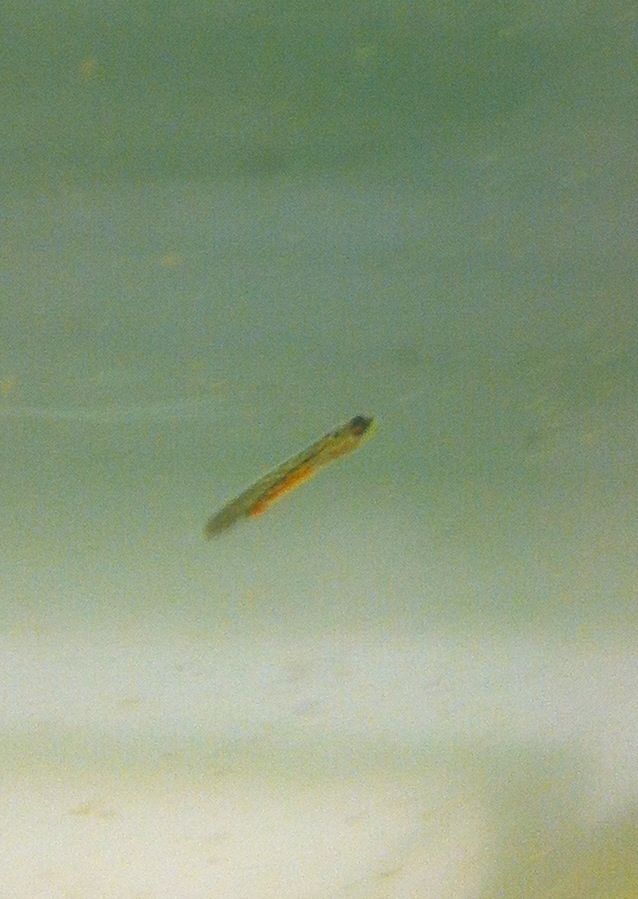
|
|
|
|